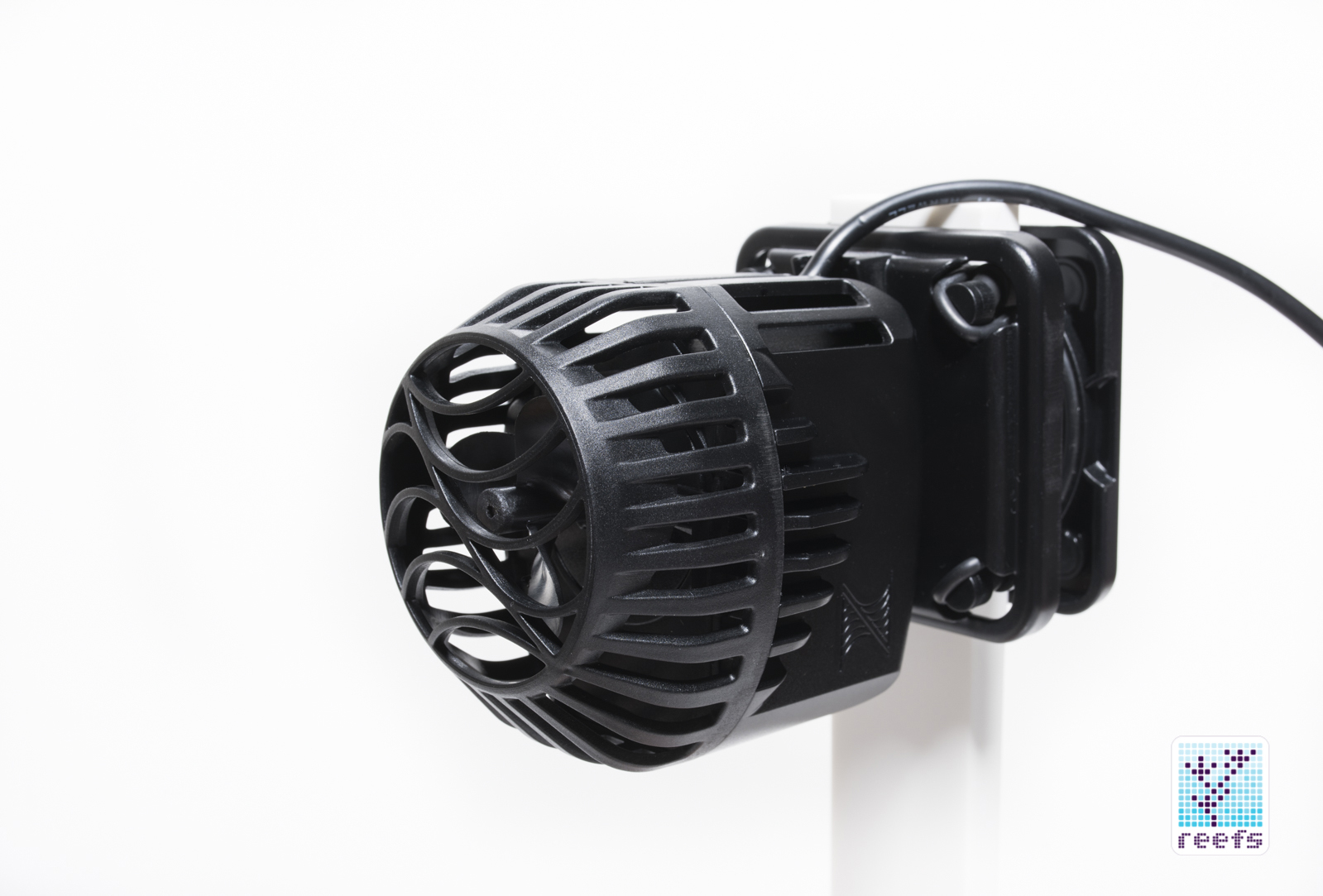
All images by author
There has never been a better time to be involved in an aquarium hobby than now; the last decade has brought a staggering number of new solutions and improvements to the industry and to our understanding of keeping a healthy fish tank. We witnessed LED technology rise to dominance, saw the importance of water movement in a reef aquarium, learned how to provide corals with optimal parameters in order to keep them in best shape, understood how to supplement the tank to achieve chemical equilibrium and most importantly, improved practices and methodology throughout the entire industry to make it sustainable.
We aquarists achieved it all through communication, shared knowledge, and adopting new technologies as soon as they were available to the public. When you think about it, aquarists truly are pioneers in putting new inventions to work. There was a DIY LED light above many hobbyists’ aquariums way before you could find it in a form of light bulb at the local home improvement store. Connected home? Remote viewing and control of equipment was available in a fish tank when everybody still carried “dumb” flip phones. Variable speed DC-powered pumps that are now finally replacing their power-hungry AC equivalents in a lot of everyday machinery were pushing water around fish tanks all over the world long time ago.
All these technological advances are heading in the same direction- to communicate, cooperate, and feed from one another. In an aquatic setup, the role of a central communication hub is played by an aquarium controller. It is (or should be) every fish tank’s heart and brain, a device that monitors water parameters, controls other essential equipment, and alerts hobbyist of possible threats. It helps aquarists with everyday maintenance, collects data for future reference, and helps prevent catastrophic equipment fails that can wipe out a healthy enclosed ecosystem in a matter of hours.
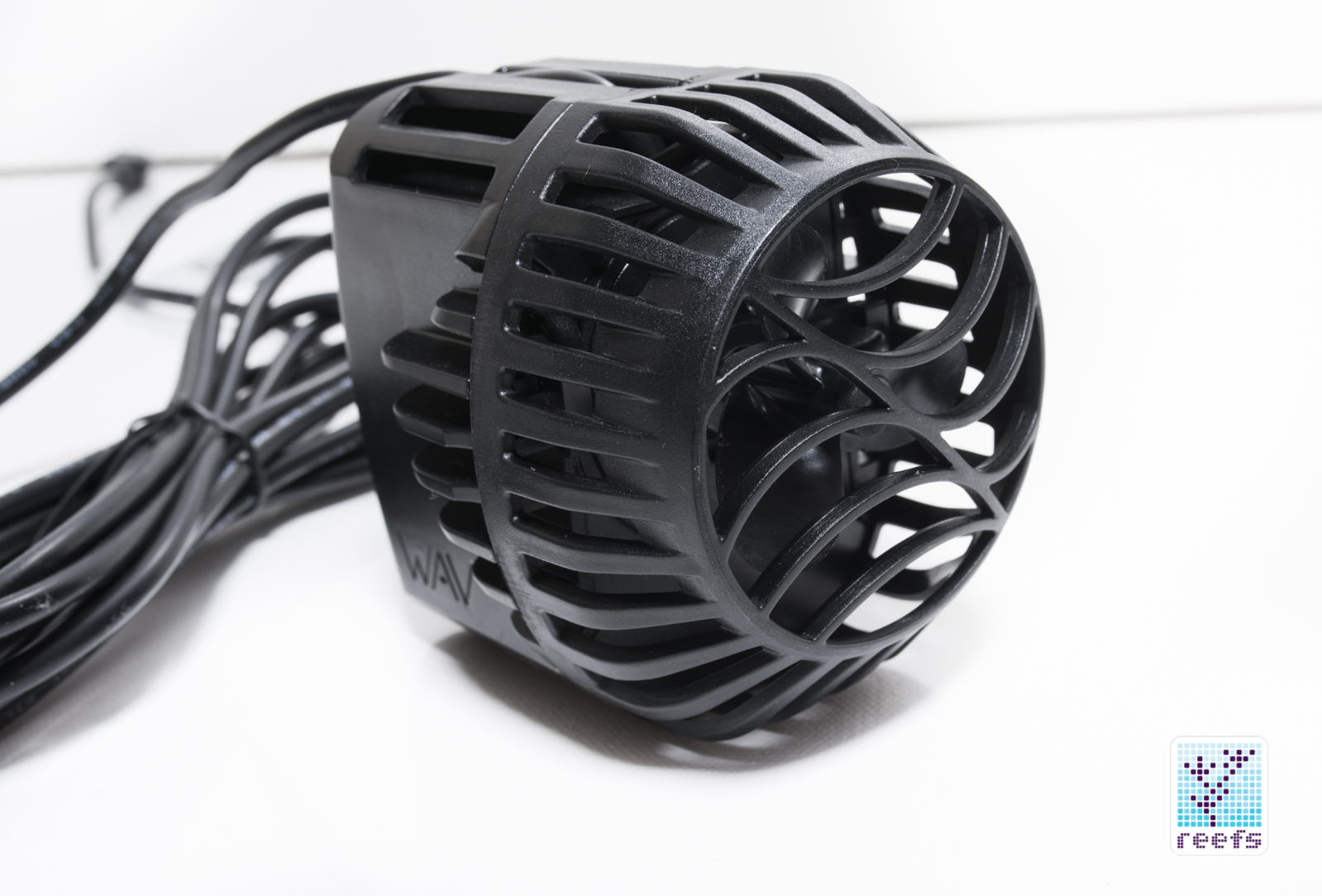
Why am I writing all this lengthy introduction? Because the subject of today’s review comes from the same company that brought us one of the greatest devices in aquarium industry’s history and it is essential to understand the importance of this company’s influence in the hobby…
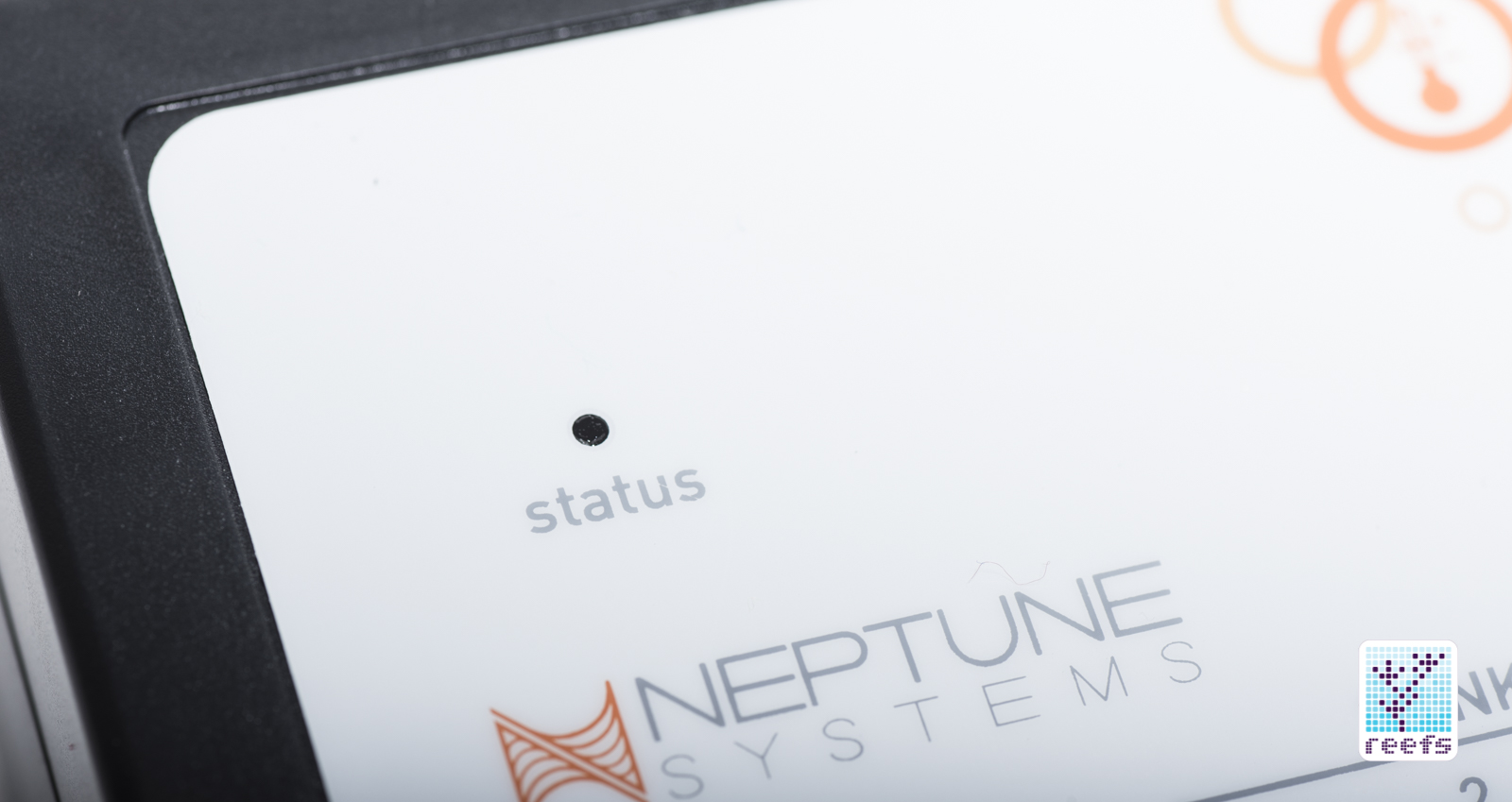
The name neptune Systems is familiar to almost everyone in the fishkeeping hobby. Right after the company was founded (in 1996), they came out with a revolutionary device called the Aquacontroller. It was one of the first widely available aquarium monitoring devices. The success behind the original aquacontroller was due to the fact that it could do much more than just monitor equipment. Its second iteration, the Aquacontroller III, had programmable 120V outlets and could alert an user of equipment failures, temperature changes, and a few other things. Years later, the Aquacontroller was replaced with the invention that really put Neptune Systems in the spotlight – the apex Aquacontroller. That thing changed everything- its modular design, expandability, the number of different probes you could hook up to it, and finally, the fact that for the first time, you could remotely view and control your aquarium from anywhere there was an Internet connection. It wasn’t perfect, obviously- there was a steep learning curve and it was quite expensive for an aquarium specific device. Nevertheless, people who could afford it back then foresaw the potential it had and Neptune Systems quickly realized apex was their flagship device that they should focus their resources on.
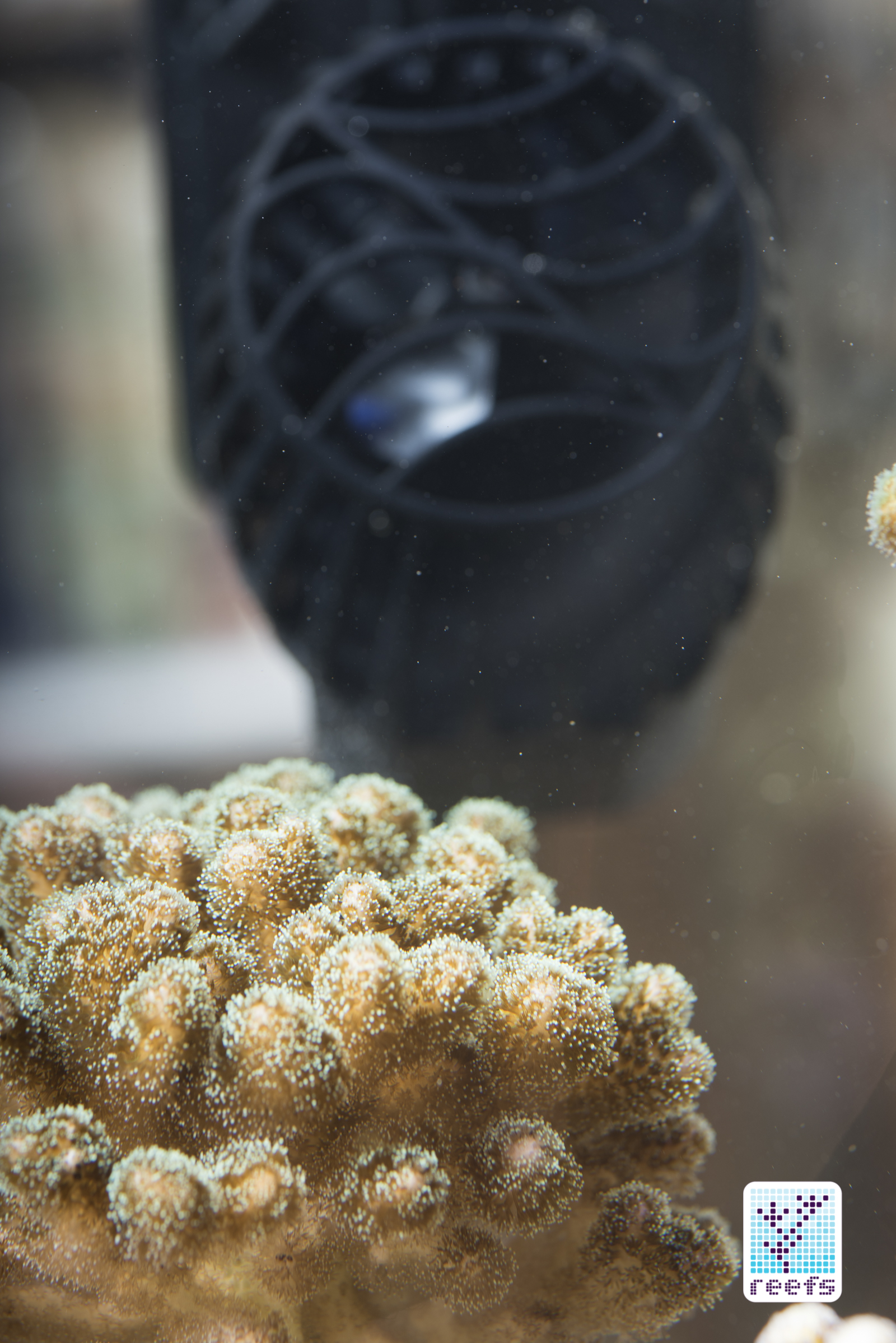 Throughout the years, Apex Aquacontroller went through many changes, software updates, and expansion modules. The company’s devotion to apex really paid off- today it is undeniably the most widely-used and recommended aquarium controller on the market. With a beautiful to look at, fully customizable, web-based interface and mobile apps, highly visual approach to programming and a huge offering of peripheral devices (both built in-house and third party) that can be hooked up to it, there is no other device that compares.
Throughout the years, Apex Aquacontroller went through many changes, software updates, and expansion modules. The company’s devotion to apex really paid off- today it is undeniably the most widely-used and recommended aquarium controller on the market. With a beautiful to look at, fully customizable, web-based interface and mobile apps, highly visual approach to programming and a huge offering of peripheral devices (both built in-house and third party) that can be hooked up to it, there is no other device that compares.
I have to admit, I am somewhat biased when it comes to new additions to the apex family, but only because I am a huge fan of Neptune Systems controller and, as you will see later in the review, being a current apex user makes a difference in judging the WAV pump.
I would like to approach this review as I was presenting it to someone not yet familiar with apex and therefore, if you already own one, you can skip the next paragraph. For everyone else…
apex PLATFORM
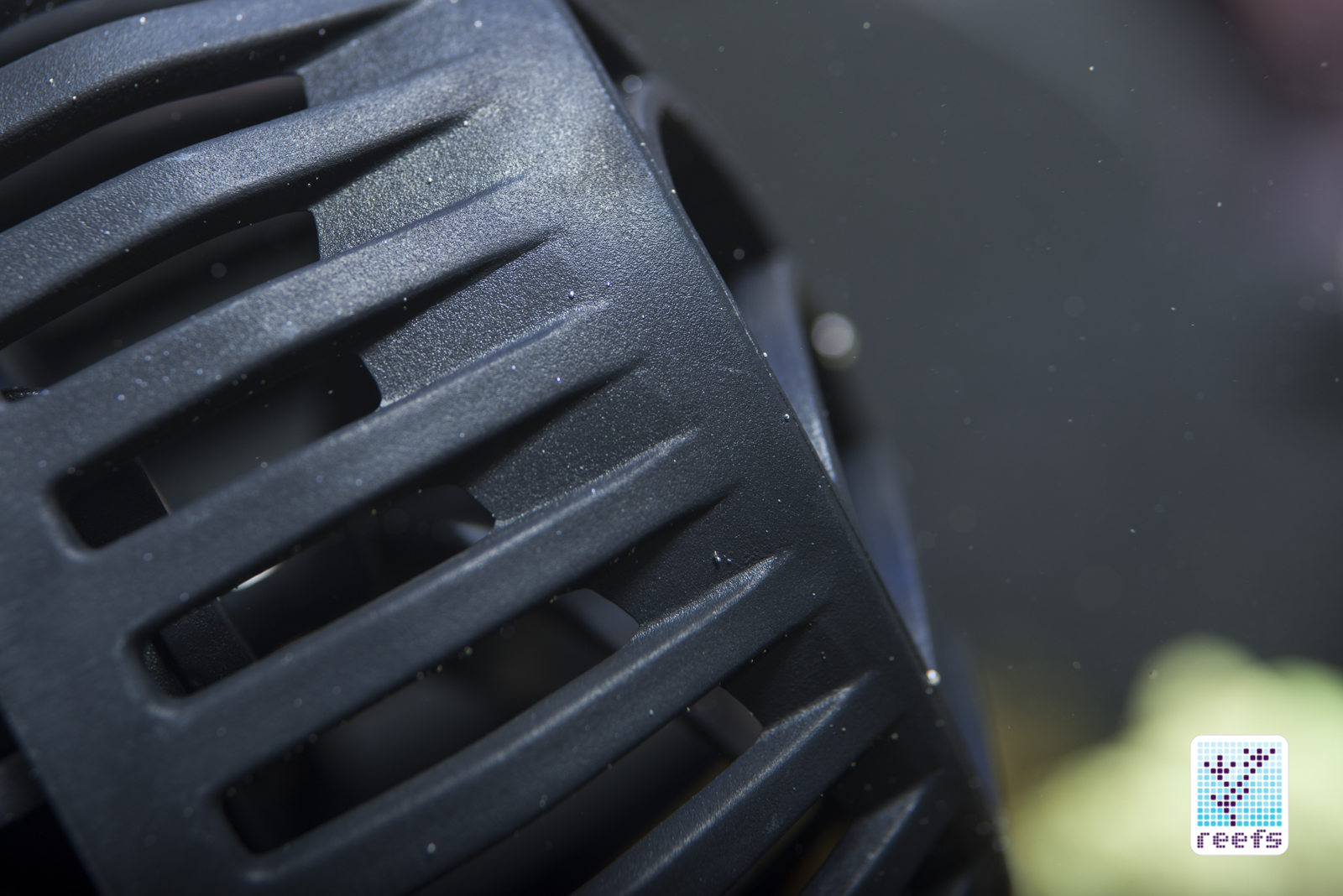
Neptune Systems has an unique market model when it comes to the apex family of products. It resembles the custom-built PC computer circle, where a single device, a motherboard of sorts, plays a central role in the platform, while all other devices are hooked up to it and cannot work without it. apex Aquacontroller is that motherboard, a heart and brain of the entire web of interconnected devices. The main difference in this hypothetical comparison is that with apex, the majority of the add-ons are made by Neptune Systems (although there is a growing base of third-party devices that can be programmed by apex). Therefore, by buying any of the recent add-ons the company introduced, like the DOS dosing pump, the Leak Detection Module, PAR meter or others, you need to have apex Aquacontroller in order to use them. WAV pump is no different.
To help understand how the idea behind apex translates in real world, let me explain the platform briefly. First, an aquarists needs to buy an apex Aquacontroller. Depending on the amount of money he or she is planning to invest, Neptune Systems has several base kits available, starting with the most affordable apex Jr. that comes with Energy Bar with 4 programmable 120V outlets and a temperature probe, all the way to the to the crème de la crème apex Gold with 8 outlets and 5 different probes (ph, ORP, salinity, temperature and conductivity). The apex is then set up for a particular aquarium(s) and other equipment plugged into its energy bar.
Then comes the other half of the apex Platform. The controller can be connected to an ethernet port and controlled via Neptune Systems’ own web portal, called apex Fusion, and/or with smartphone app (available for Apple and Android devices). Using a simple program code, or a series of sliders and interactive graphs, apex can be viewed and tweaked from anywhere. The possibilities of aquarium automation using apex are endless. People have them set up to control fish tank’s lighting, heating, moisture detection, feeding the fish remotely with automated feeder, dosing chemicals and most recently, to create optimal flow in their tank…
WHAT IS WAV?
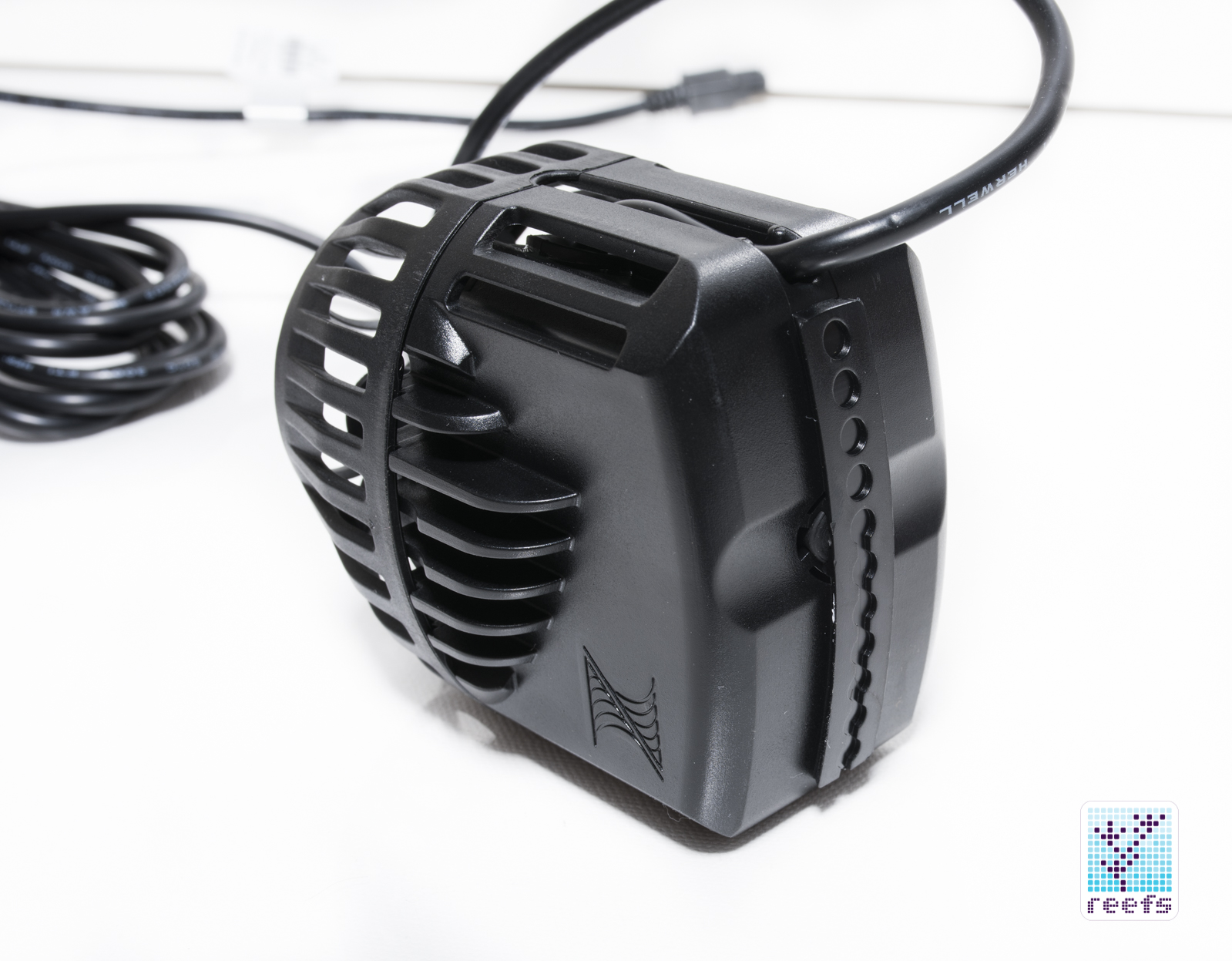
Which brings us (finally!) to neptune Systems’ latest product, called simply WAV. In essence, it is a DC-powered, variable speed propeller pump, but with a twist: unlike most other propeller pumps, WAV will not work without apex controller. There’s no secondary controller to it and no way to just plug it into a wall and drop it in the aquarium. I’ve read opinions online where some people saw inability to run WAV alone as a huge disadvantage, but frankly, who would invest hundreds of dollars in a pump that would work only in “constant flow” mode, when there are cheaper alternatives readily available. It also might be viewed as a weird decision on the manufacturer’s side to limit their customer base to only those who already own their other product, but in my opinion, it mainly shows the confidence Neptune Systems has in their apex platform (and rightly so). That being said, it has to be taken into consideration that to “start from scratch” and purchase both apex and WAV, an aquarist needs to shell out a significant amount of money.
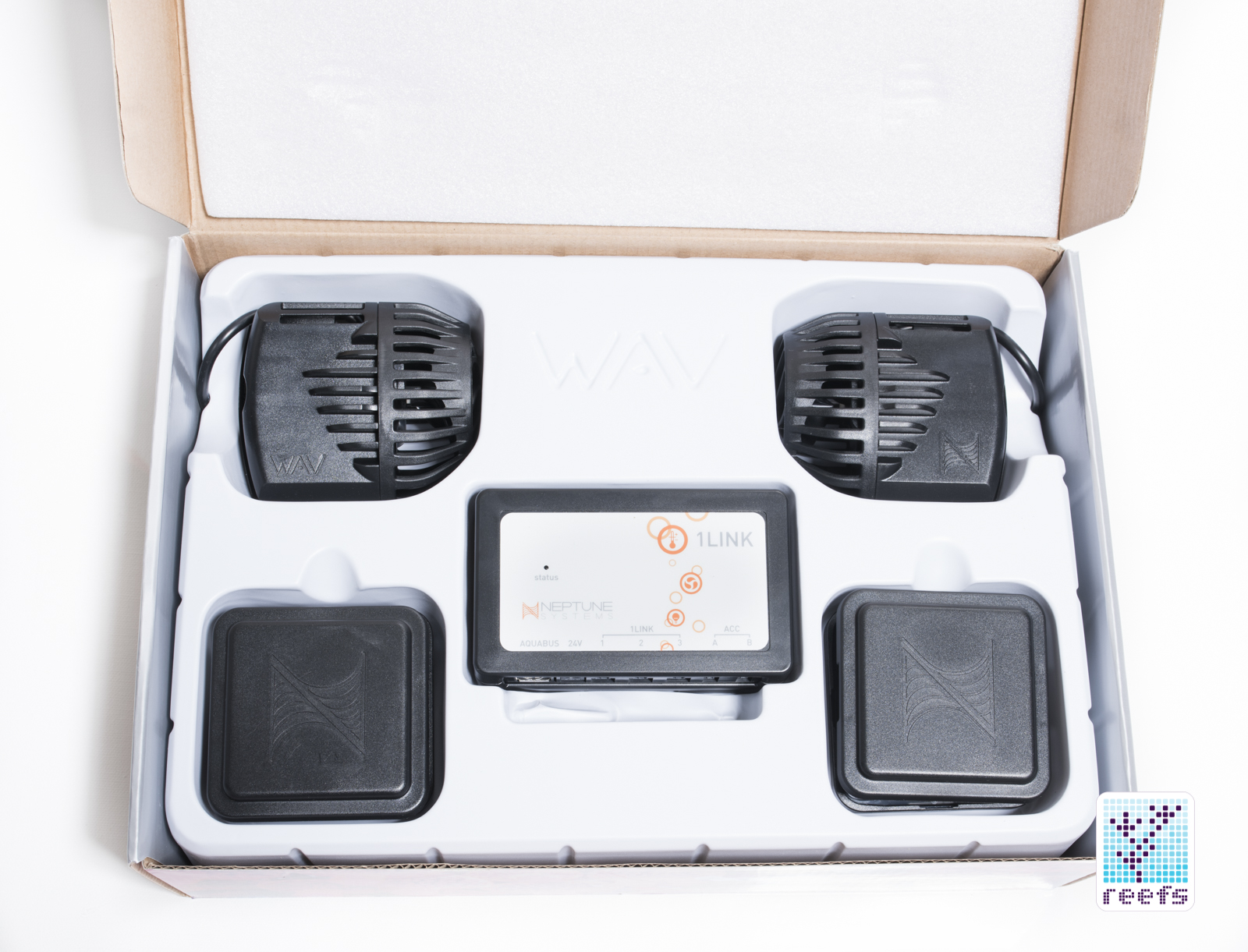 Here’s how the WAV pump works- the standard kit comes with two WAV pumps, a 24V AC/DC adapter and a 1 LINK module that is necessary for communication with Aquabus (Apex Aquacontroller central hub). An aquarist then can expand the system by adding additional WAV pumps and/or 1LINK modules. The pump is fully integrated into the apex platform and can be programmed just like any other Neptune System accessory.
Here’s how the WAV pump works- the standard kit comes with two WAV pumps, a 24V AC/DC adapter and a 1 LINK module that is necessary for communication with Aquabus (Apex Aquacontroller central hub). An aquarist then can expand the system by adding additional WAV pumps and/or 1LINK modules. The pump is fully integrated into the apex platform and can be programmed just like any other Neptune System accessory.
UNBOXING
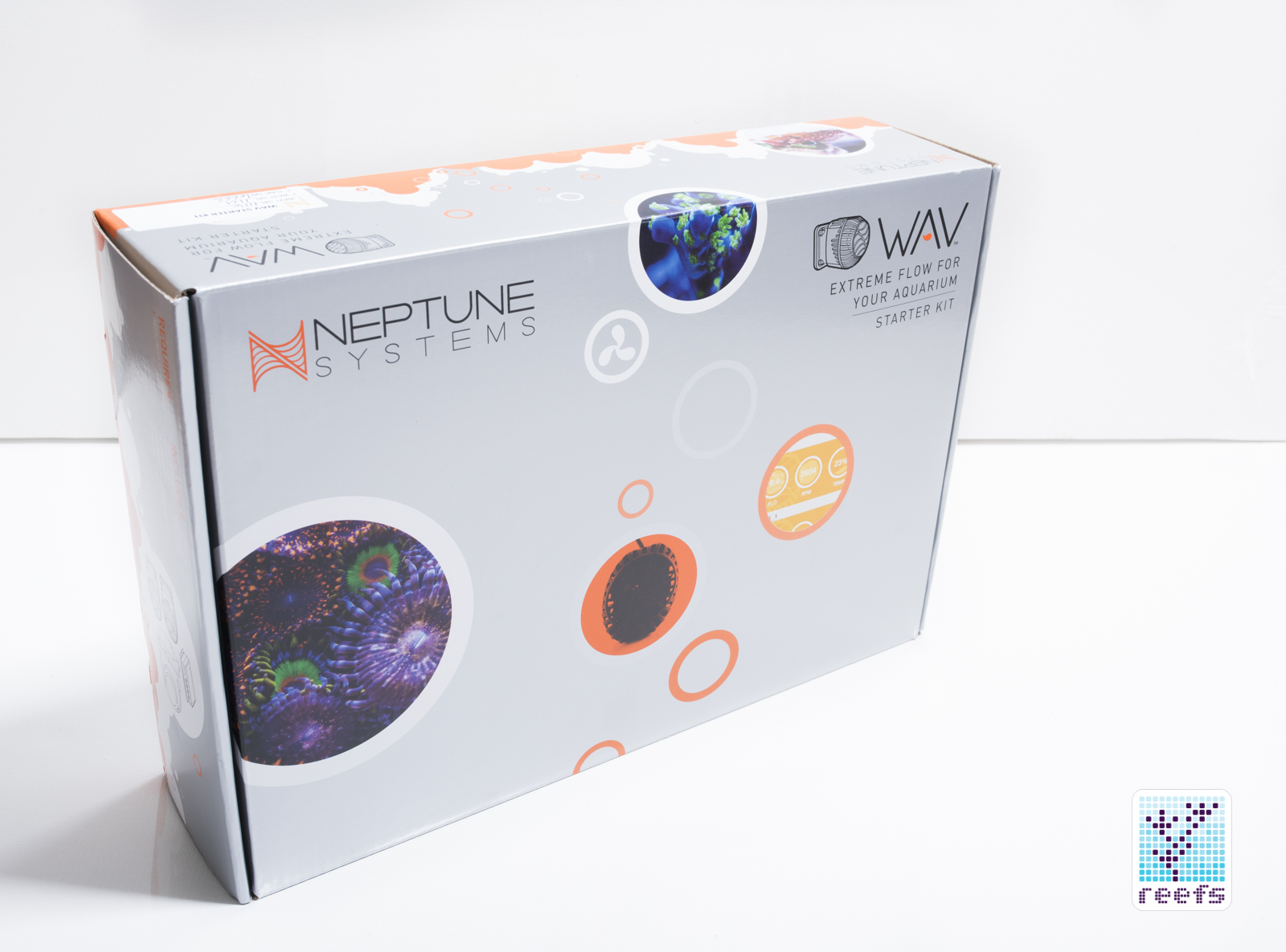
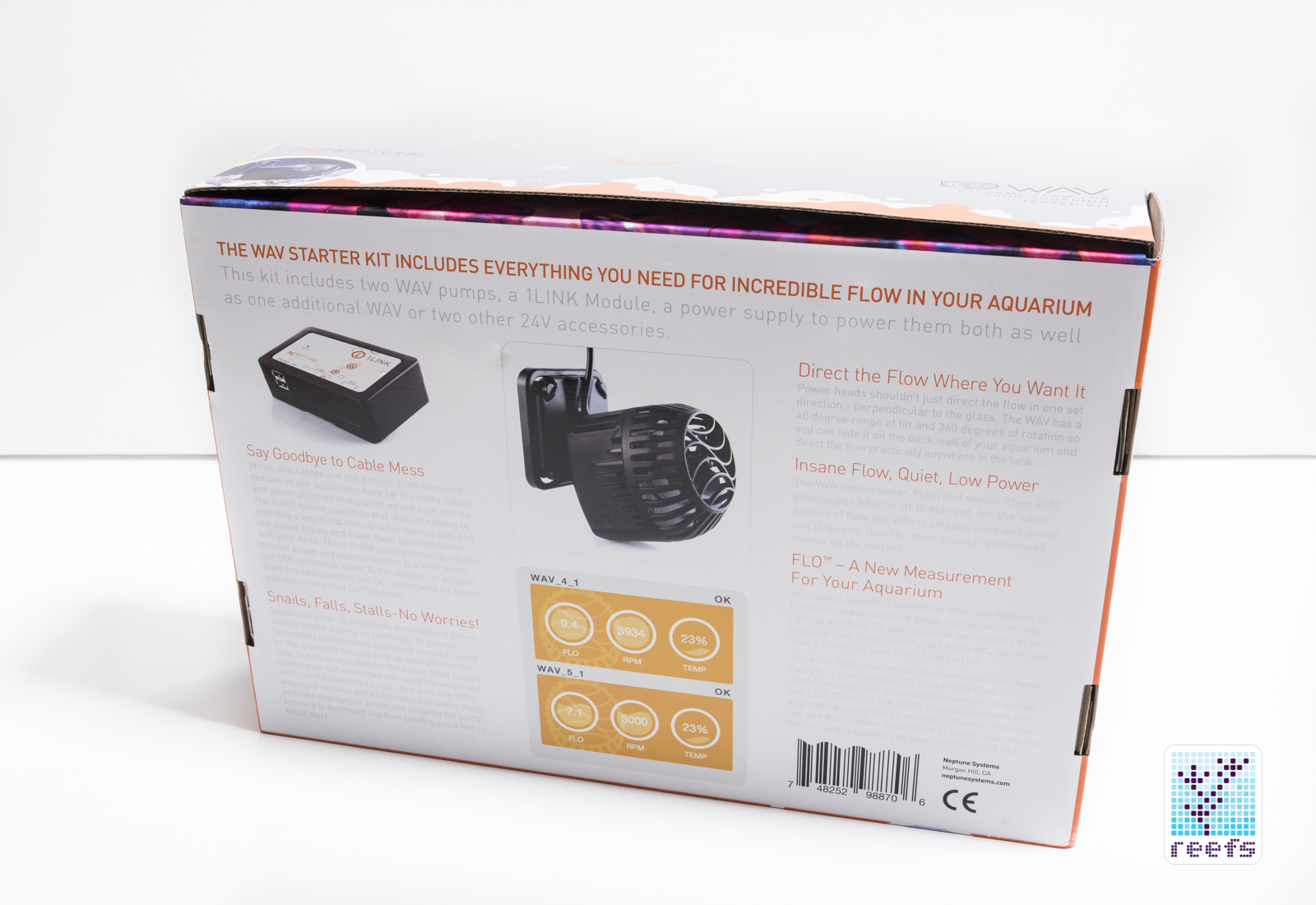
I received the retail version of WAV starter kit up for this review, packed in a nice, shiny box. Inside it, there are:
- Two WAV powerheads
- A set of matching magnets for each pump
- 24 VDC power supply and AC cable
- One LINK1 module
- 3’ long (1m) Aquabus cable (to connect LINK1 with apex Aquabus)
- A set of screws to mount LINK1 to a wall
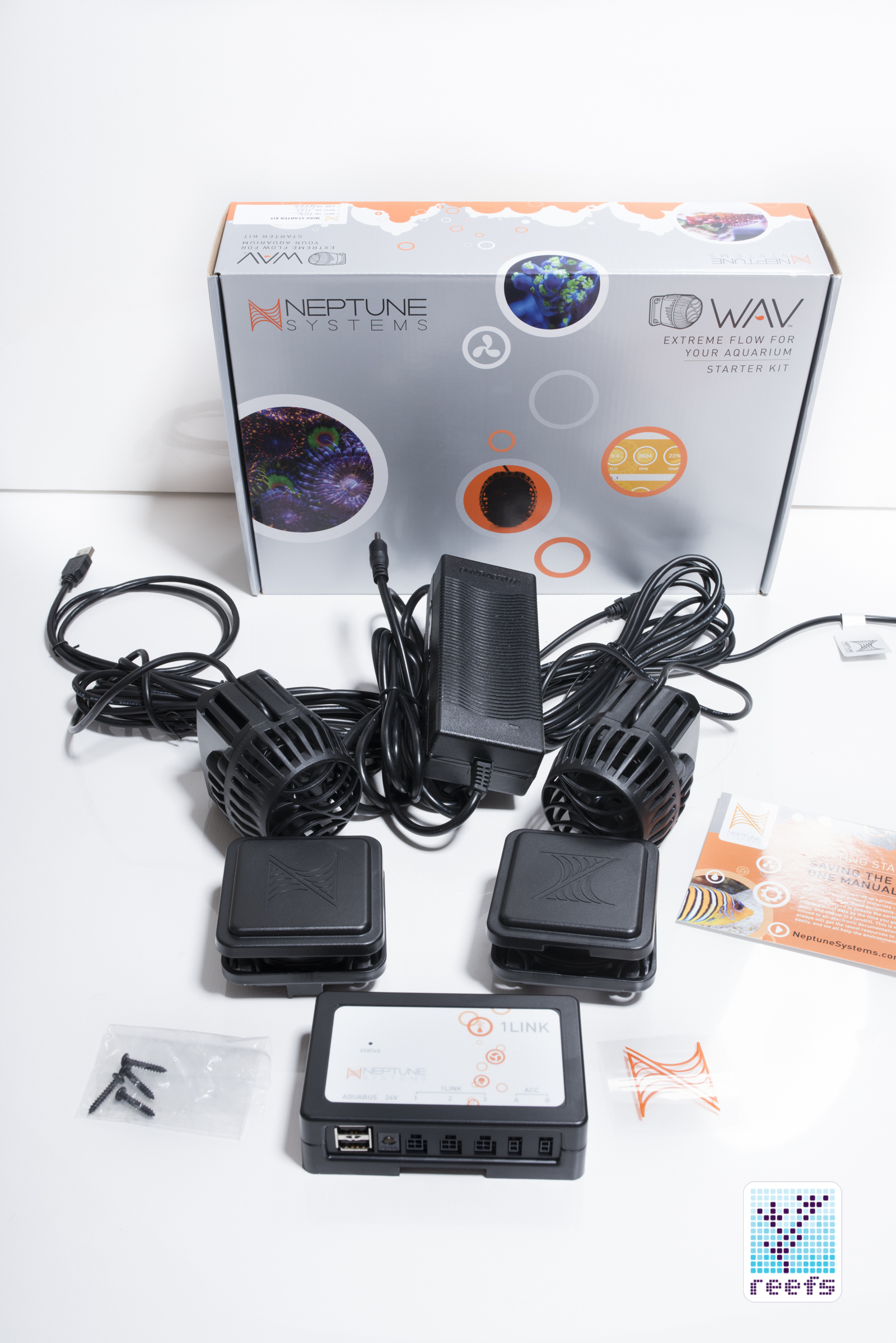
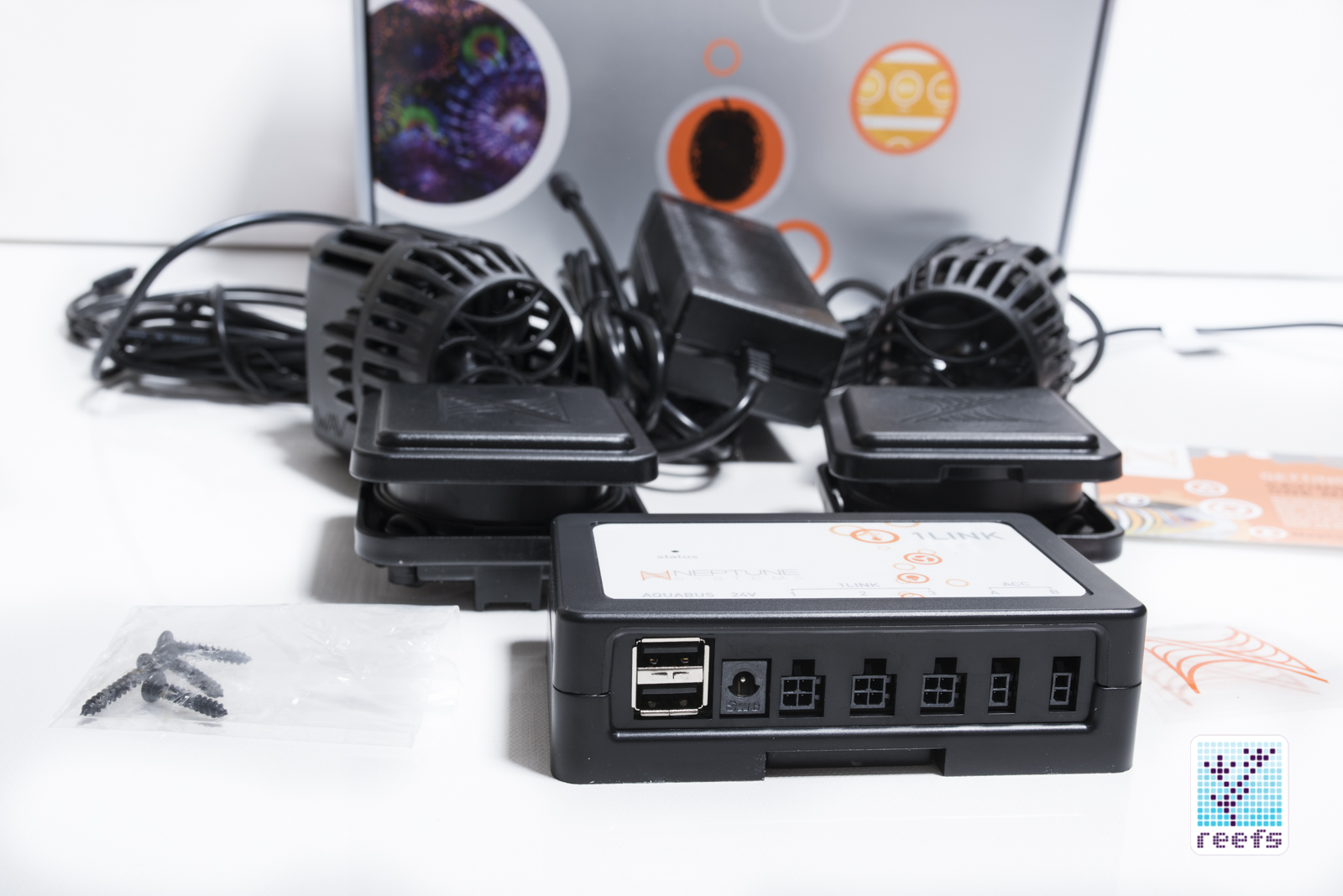
A complete instruction manual can be downloaded HERE.
ON PAPER
neptune Systems advertises the WAV as being able to create 4000 gph of flow, using only 35 Watts of power at its highest setting. They also promise that WAV will push all that water while making less noise than the other leading pumps on the market. The accompanying software offers 7 flow modes and the pump itself is equipped with sensors that detect its position, the water level, and internal temperature, cutting off power in case any of them detect anomalies.
WAV PROPELLER PUMP
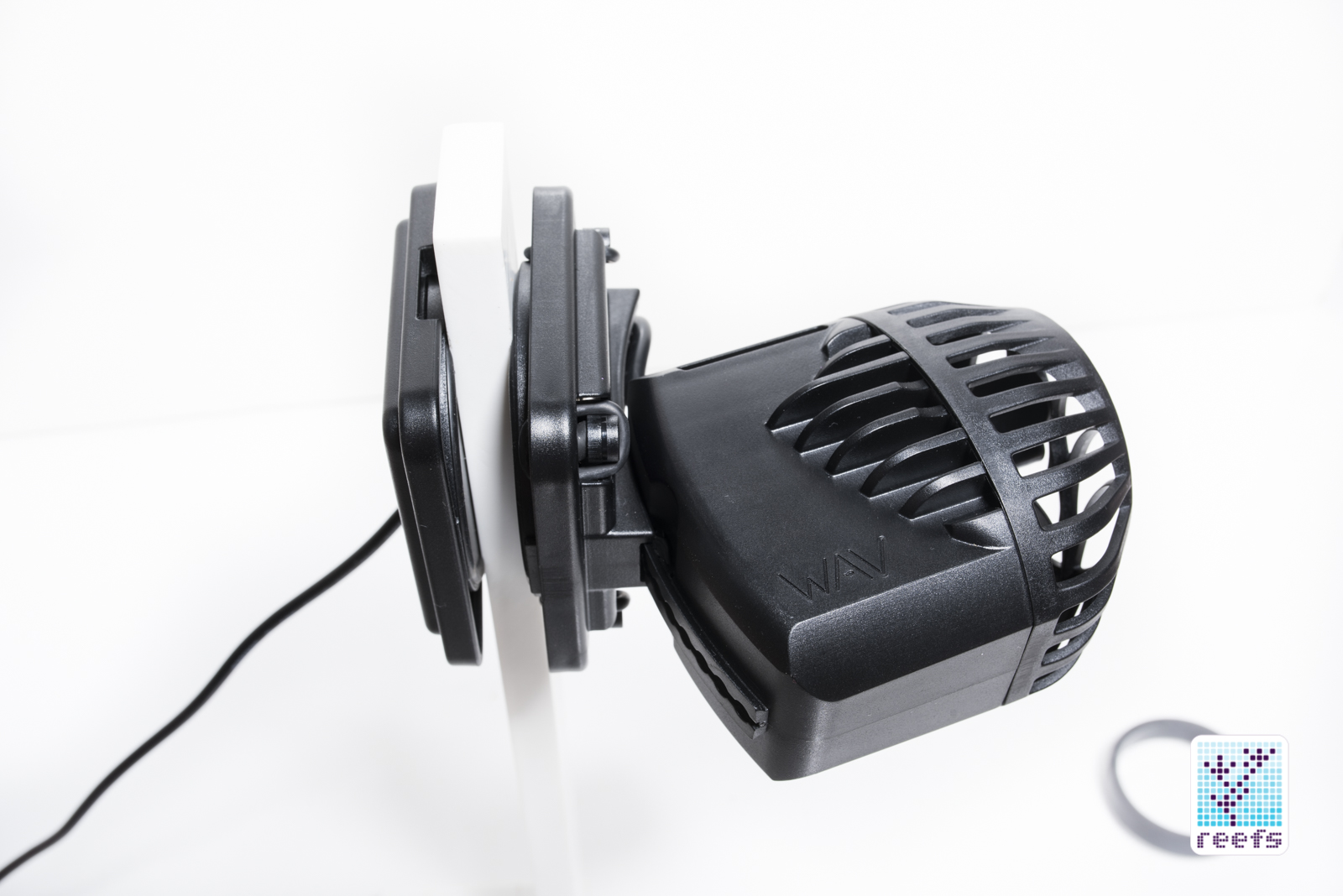
The main component of the WAV kit, the DC-powered propeller pump, is a solid piece of equipment. It is made out of an impact-resistant black plastic and it connects to the magnet through a neat slider that allows the pump to swivel 20 degrees in either direction from its perpendicular-to-the-aquarium-glass position.
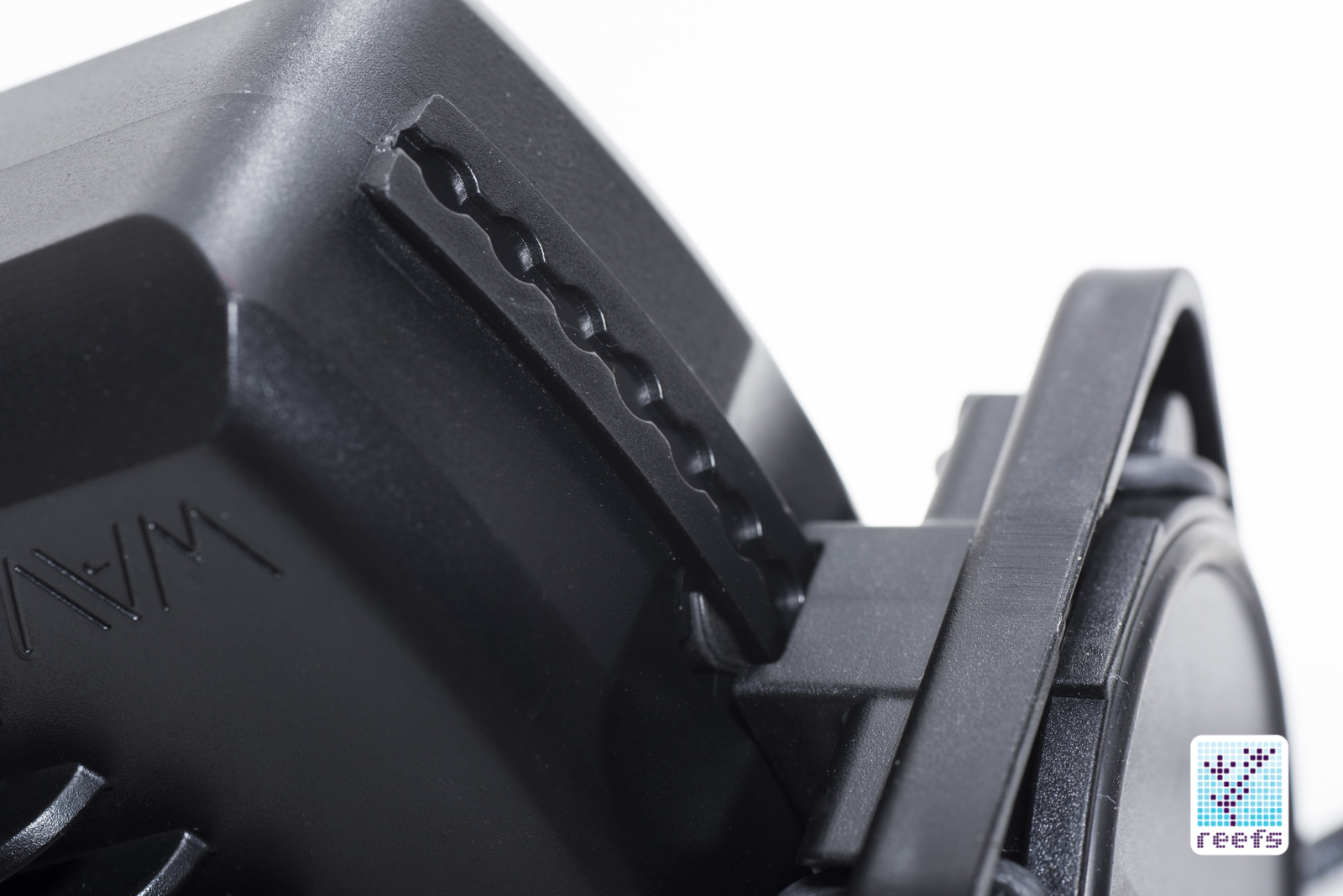
The pump then attaches to the glass with the outside magnet and the whole thing can be rotated, so that it pushes water diagonally to the surface after it is mounted. This clever design allows for directional flow within 40 degrees off its axis. To change direction of the flow, you simply move the pump on the rail in magnetic holder.
On one hand, it’s more work to move the pump around, compared to a standard ballhead or swinging-arm adjustment seen in most pumps, but on the other, once you set the desired position, the pump will not move, even if you accidentally bump into it while doing maintenance.
The magnetic holder has no problem holding the pump on a 1″ (25mm) glass (I actually used a 1″ corian piece instead, but I don’t see how would it differ on glass). In fact, I’ve never seen a magnet that strong- when I was removing the spacer in between the two sides and accidentally stuck them together, I had to use all my energy to slide them past each other to separate them. I personally think neptune System should include a spacer for glass ¼” thick, because it’s almost scary when you align them and they force into each other through the glass.
The thing that really makes WAV unique is the set of sensors that sits inside of it. First, there’s an interior temperature sensor that will cut power off to prevent the powerhead from frying whenever it’s running too hot. Next, there’s a motor stall sensor- the pump shuts down when something blocks the impeller. We all know at least one story of someone who had his/her livestock wiped out by an anemone that decided to venture into the impeller. The next two sensors are even more advanced- the water level sensor triggers when the pump is taken out of water and then there’s a sort of proximity sensor (at least that’s what I believe was used) that will shut down the pump if it yaws from its preset, original position. It has at least two uses- to inform an aquarist that WAV was moved or bumped into or to save someone’s rear when the outside magnet is removed and the pump drops down to the sand creating havoc in the tank.
The beauty behind this impressive set of sensors is that you can program all or each one individually to send you email or text alerts right away if they get triggered. You can also switch any of them off if you wish.
WAV’s physical appearance leaves little to be desired – it’s sleek, light, and doesn’t take up that much space in the tank, even given its claimed 4000 gph flow rate. It is naturally compared, by hobbyists and reviewers alike, to two of its main competitors in the same price bracket – the vortech MP40 Quietdrive and the Tunze 6105. Someone on a fish forum described the look of WAV as if Tunze 6105 and vortech MP40 had a baby and I couldn’t agree more. It has something from both these pumps, but also stands out on its own. The flat sides, square shaped magnetic mount, the swivel, and a grill cover that resembles neptune Systems logo make it unique and original.
WAV pump’s disassembling process is a breeze. The grill cover simply snaps in and off, while the motor impeller is accessed by turning a plastic cover counterclockwise and pulling it out of the assembly.
1LINK MODULE
The 1LINK module that is included in the WAV starter kit is, itself, a very interesting device. Despite the misinformation surrounding some online forums, 1LINK is not WAV driver in the “classical” term. In fact, as Neptune Systems stated themselves, the entire driver electronics sit inside the pump rather than in a separate controller, such as with vortech or Tunze wavemakers.
1 LINK acts as a distribution panel (the size of a pack of camping matches) that provides power and communication signals to WAV pumps. One 1 LINK module can power and control 3 pumps without any additional controllers or power bricks. It can also be paired with neptune System DOS dosing pumps (with an accessory cable) or the yet not introduced return pump with a code name COR. If that wasn’t enough, 1 LINK has two smaller, accessory ports that provide a 24VDC power.
neptune Systems’ team states these ports are for the company’s future devices and/or to power up DIY devices hobbyist build themselves. It’s a promise from neptune Systems that the 1 LINK module will be used on many of their upcoming offerings.
Why all the hassle with a separate distribution box? One thing- less wires and less power adapters. If you’re planning to only have one propeller pump in the tank, then there’s no real advantage to the system, but if you have two or more pumps, it really cuts down on the amount of mess behind the tank. One wire with power brick to connect to 120V, one USB-like cable that goes to Aquabus, and one wire for each propeller pump or other device.
With the introduction of 1 LINK, Neptune Systems is trying to convince you that if you invest in apex Devices, you will be saving money in the long run – the company cuts costs by not including power adapters and controllers, and in turn can keep the price of their products competitive.
INITIAL SETUP
Setting up a WAV kit is a two-stage task. First, I mounted the 1 LINK on the wall, connected it to an aquabus on my apex Jr that controls the reef tank (the full size apex sits behind my planted aquarium), and plugged the power adapter into the wall. A little green diode lit up on the 1 LINK and I was ready to position the two pumps and plug the cords onto a 1 LINK ports.
That’s the hardware part. The second part involves setting up the program within apex’s web interface (or on apex display if you are a masochist:) ). When all pumps are plugged into the 1 LINK, apex software creates two new programmable outlets, one for each WAV wavemaker. My Fusion dashboard (apex web interface’s main page) shows two new tiles, each having 3 different parameters displayed- the internal temperature, the RPM that the pump is running at, and a tile labeled simply FLO.
By clicking at the either one of the WAV outlets, you enter the program mode.
PROGRAM
WAV can be programmed on both the classic web interface or in apex Fusion. I won’t bother explaining how to do it in classic interface (is anyone still using it ?) and will focus on Fusion instead.
WAV’s programming interface is very simple to follow and does not require any knowledge of the apex programming language. When you enter the scheduler, you are presented with a two dimensional graph representing the 24h timeline on its horizontal axis and 0 to 100% motor speed on its vertical line. You can modify the daily flow curve by adding points to the graph at specific times where you want changes in the flow pattern and speed. When in wave-making modes like pulse or pipeline, an additional slider representing time interval in between pulses shows up on the screen. The level of customization WAV provides is staggering and should satisfy any control freak. An average daily schedule may include a gentler flow in the morning, followed by a more energetic water movement throughout the photoperiod, and ending with a dialing back down throughout the night. You can also “go crazy” and program as many different flow pattern as you wish.
If that wasn’t enough, WAV, being fully integrated with apex environment, can react to other changes in the tank when you program it into other Aquabus outlets and scenarios. For example, you can program WAV to shut down with other equipment during maintenance or feeding, as well as when a sensor of your choice reaches a certain point. WAV, with its built-in sensors, will inform you via text or email of any disruptions in its operation.
FLOW MODES
WAV has a wide variety of preprogrammed flow patterns, comparable to the new Ecotech Vortech line, but with the advantage of full apex support. As I mentioned in the previous paragraph, having an ability to change flow pattern during the day opens up a world of possibilities. Again, a lot of people won’t care about this extra perk and will leave the pump on one mode for the entire time WAV operates, but even a day/night cycle is an attractive option.
WAV’s range of flow patterns include seven distinct modes plus three variations available when more than one pump is connected to 1 LINK. I’ve tested all of those modes and here are my observations:
- Constant- this mode does not require explanation and frankly, will not be used by 99.9% of WAV users
- Mavericks- a random, strong flow, best for larger tanks and SPS coral keepers
- Malibu- similar to Mavericks, but less intense flow pattern, intended to use on soft coral and LPS dominated aquariums
- Pulse- classic mode intended to produce a standing wave, speed and time interval in between pulses can be customized to user’s needs
- Pipeline- a stronger version of pulse, in this mode the minimum to maximum speed ratio is higher than in pulse
- Rincon- a sophisticated flow pattern in which the pump goes through 87 minutes cycles- each cycle consist of a first phase where pump increases speed slowly over a period of about 20 minutes and then decreases in another 20 minutes; the second part of the cycle is identical, but with half the speed of the first phase
- Trestles- another extended time cycle; first phase consist of a slow but uniform rise in flow, followed by equally intensive reduction in flow; then the second phase is a series of very rapid pulses; the whole cycle lasts almost 90 minutes
These are the main 7 flow modes, available when one pump is connected to 1 LINK. For two of more pumps, a user sets the Reference pump and an additional 3 modes show up in the program:
- Mirror- it’s a simple synchronized mode; you can choose any of the 7 main modes for the reference pump and all other pumps will synchronize and follow the same pattern
- Inverse- this does the exact opposite to mirror mode, asynchronizing two pumps in their operation; for a simple modes, like pulse, two pumps will turn on alternatively, creating a standing wave in the tank; for more advanced modes, like trestles, a reference pump follows the normal flow pattern, while the second one does the pattern in reverse;
- Back- neptune Systems advertises this mode as being specific to pumps mounted on the back wall of the tank, it follows a gentle curve where first half is a constant rise in flow and the second, a uniform decrease in flow; all other pumps are synchronized with the reference pump in this mode
I was testing two WAV pumps, therefore I cannot comment on how the program looks for more wavemakers, especially with the Inverse mode, but I believe it can be set up in apex to have them as you like.
THE FLOW VS NOISE
I have to say it up front- after testing the pump over several days, one thing is certain- WAV can produce some serious flow. There is no way to measure the actual output versus advertised without special equipment, but I put WAV in the same league as the Ecotech vortech MP40 QUIETDRIVE I reviewed recently. The flow pattern is somewhat narrower than some other leading pumps, which works great in larger tanks, but can be problematic in smaller aquariums. I could not use the WAV in my 35 gallon tank, even when I dialed the speed down to 1%, without creating a sandstorm. In my opinion, a 4 foot long aquarium is a minimum size for a pair of WAV and that’s assuming a high-energy reef flow is desired. I think neptune Systems should come out with a smaller impeller or an entirely new, smaller model, to widen their audience. I cannot blame the manufacturer for misleading me, because it is clearly written on the box that WAV is a 4,000 gph pump, but being spoiled with other manufacturers having several models of the same line, I somehow assumed WAV is going to be a “one solution for it all”, which is not the case. Please don’t take the massive flow this impeller pump produces as a flaw, because it clearly isn’t, but at the same time, don’t expect, as I have to admit I did, that WAV can be used in a nano to mid sized tank.
Speaking of flow, I was tremendously impressed of the brute force WAV hides within its body. I obviously had to move the pump to the 100g, 48″ long tank for the noise test, as at merely 25% it would probably have created a tsunami in the my 34g reef cube, and seeing it producing a standing wave on pulse mode was a jaw dropping experience. I remember testing the new vortech MP40 Quietdrive, which by the way I really liked too, on the same exact tank and to my unscientific, hobbyist grade eye, WAV produces more flow. Not a lot more, but observably more.
The preprogrammed modes offer a great variety of flow patterns and, when you make changes in the apex program, the pump reacts immediately. In summary, when it comes to flow, WAV leaves nothing to be desired and, in my opinion, a pair of those “monsters” can easily be enough for a tank up to 250-300g.
Noise became a big concern in hobbyists’ discussions recently, mostly do to a so-called “spouse factor”, (where an aquarist does everything and anything to make her/his aquarium unnoticeable to the ears of other home-dwellers) and in this regard, WAV does not disappoint. It is virtually silent on speeds lower than around 50%, while above it, you need to get really close to the tank to notice it running. On its maximum setting, you’ll hear very little of the actual motor noise and more of water being chopped and displaced by the impeller, a sound that quickly dies within the ambient sounds that an entire large aquarium makes. Here are my noise test results for one WAV, set to Constant flow mode 3 different speed settings- 25%, 50% and 100%. The test was done using a consumer-level digital sound meter set to A-weighting noise measurement. I measured an ambient noise 10 times before the test, averaged the results and observed a noise level change when the pump was in motion.
Ambient noise (averaged 41.7 dB)
At 25%
At 50%
At 75%
At 100%
The noise cancellation solution implemented into the magnetic mount is equally effective; you won’t hear or feel any pump rattle during its operation.
SENSORS
The sensor test left me equally as impressed as the noise test. I didn’t perform a temperature test, as that would have to involve me increasing the surrounding water temperature to extreme levels, but I did test the obstruction, water level and proximity sensors. All of which, when engaged, create an instant reaction on the WAV and the apex software that immediately sends a text message when one the sensors triggers. I was the most impressed with the water level sensor, simply because it allows for a quick cleaning of the impeller assembly without even turning the pump off. The second you take the pump out of water, it stops. I don’t quite understand the technology that makes this happen, but it works flawlessly.
FLO
There’s one aspect to the WAV I didn’t bring up yet: FLO in the apex Fusion dashboard. It is a flow-measuring algorithm developed by neptune Systems exclusively for their WAV pumps. apex is constantly communicating with WAV driver, collecting RPM data from the pump, and calculating flow changes in real time. The algorithm then averages the data received from the driver and assigns a FLO value based on the conditions in the aquarium. FLO scale is non-linear and ranges from 0-10, where 0 is the least flow and 10 is the maximum flow achievable. Aquarists can compare their FLO values with others having similar setups and make changes to adjust flow in their tanks. neptune Systems posts a recommended FLO range for different types of marine aquarium in their Quick Start Guide and encourages people to share data with others to help them achieve optimal values necessary to keep various marine life happy. Before one starts using FLO, apex asks for a tank volume and performs its calculations based on that value.
It is an interesting new way to monitor water displacement in the fish tank and a step in the right direction for neptune Systems- I think that flow measuring tools might be the next big thing in the aquarium monitoring equipment. Imagine a set of wave-makers and a return pump that is measuring flow at all times- you would be able to determine when it’s time for cleaning and react quickly in case any of the flow devices fails. I hope neptune Systems is preparing similar technology for their upcoming COR return pump, perhaps even with some kind of pressure sensor that would sense clogs in aquarium plumbing, as well as slow downs due to detritus build up in the pump’s impeller assembly. I am looking forward for this technology to develop further in the near future.
WARRANTY INFORMATION
neptune Systems warrants WAV for 1 year from the date of purchase and the company is known to provide excellent customer service.
PRICING & FINAL VERDICT
In order to fully understand the pricing scenario for a product like WAV, we have to create two categories- one for people who already own apex controller and one for others that don’t. If you are a happy apex AquaController owner, the starter kit, consisting of two WAV pumps, a 1 LINK with power adapter and a full set of cables will cost you a little under $500. Each additional WAV is priced at $199.95, while the 1 LINK with power supply costs $149.95. At this point, when it comes to its main competitor, the Ecotech vortech MP40, which costs $349 a piece (that is, with an electronic driver/controller) AND you are planning to get two anyway, WAV seems like a real bargain. The situation changes slightly when you don’t have apex or you own a different brand aquarium controller. In this case, the second category applies- the cheapest controller in the apex line is the Apex Jr., which runs for $240. Five hundred dollars for WAV starter kit plus the cost of apex Jr. elevates the total price to $740, which a little over $40 more than two MP40s, but with a huge added bonus of an amazing aquarium controller.
It’s hard to compare the two pumps because they are so different from each other; they are sold and operate on a different principals and therefore it is really up to an aquarist to decide which way he/she wants to go with their setup. Do I think one needs an aquarium controller? Absolutely, I believe it’s one of the most crucial pieces of equipment in a fish tank and should be a backbone of every freshwater or saltwater tank. Is apex the best you can get? In my personal experience of dealing with 4 different brands of aquarium controllers, yes it is. Not to take away from the vortech MP40 QD, which is a fantastic piece of aquarium technology, but I think WAV nailed it when it comes to the fine balance between price and features. If it only had a full line of propeller pumps instead of only one extremely powerful model, more people would jump in to try them.
What you get is a propeller pump built to quality standards, fully programmable and able to be operated remotely, with a set of extra features and components that prevent aquarium failures, that is priced very competitively on a saturated market of water movement devices. There are other pumps that offer a more elegant shape and form, a different set of unique features WAV lacks, but it’s hard to argue that neptune Systems once again proved they can put out an unique product in a field where everything seems to be already invented and improved upon.
Just please make a smaller one…
Cheers and please check back for more of my reviews and other fishkeeping articles here on reefs.com!
USEFUL LINKS
WAV promotional page https://www.neptunesystems.com/wav/
WAV Quick Start Guide (in pdf form) https://www.neptunesystems.com/downloads/docs/WAV_QuickStart.pdf
Neptune Systems community forum https://forum.neptunesystems.com/
GALLERY
- Standing WAV in author’s 100g freshwater tank
- WAV in author’s tank
- Back of 1LINK Close-up
- Back of 1LINK
- 1lINK dimensions
- 1LINK module
- WAV pump disassembled.
- WAV magnetic holder

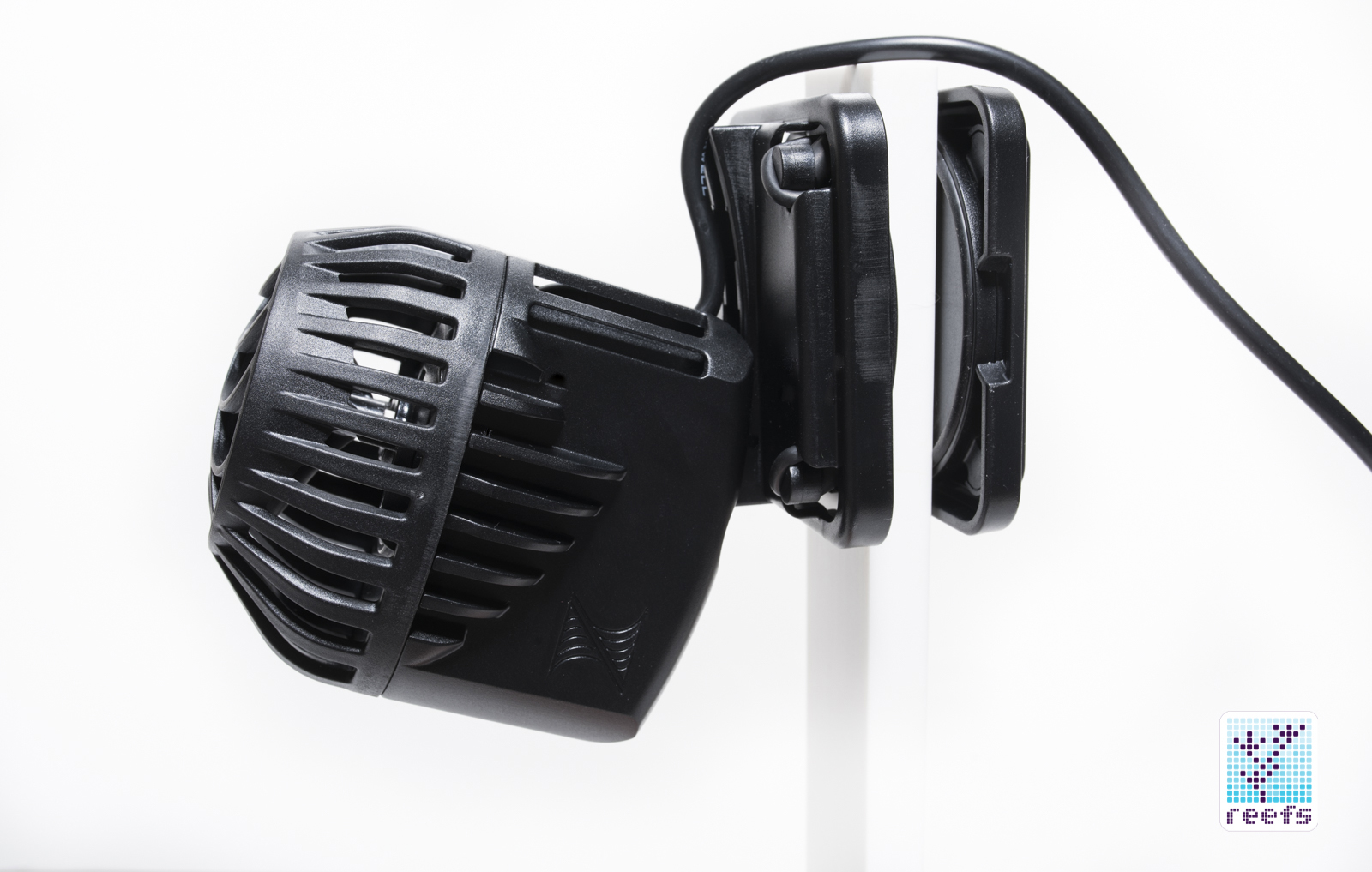
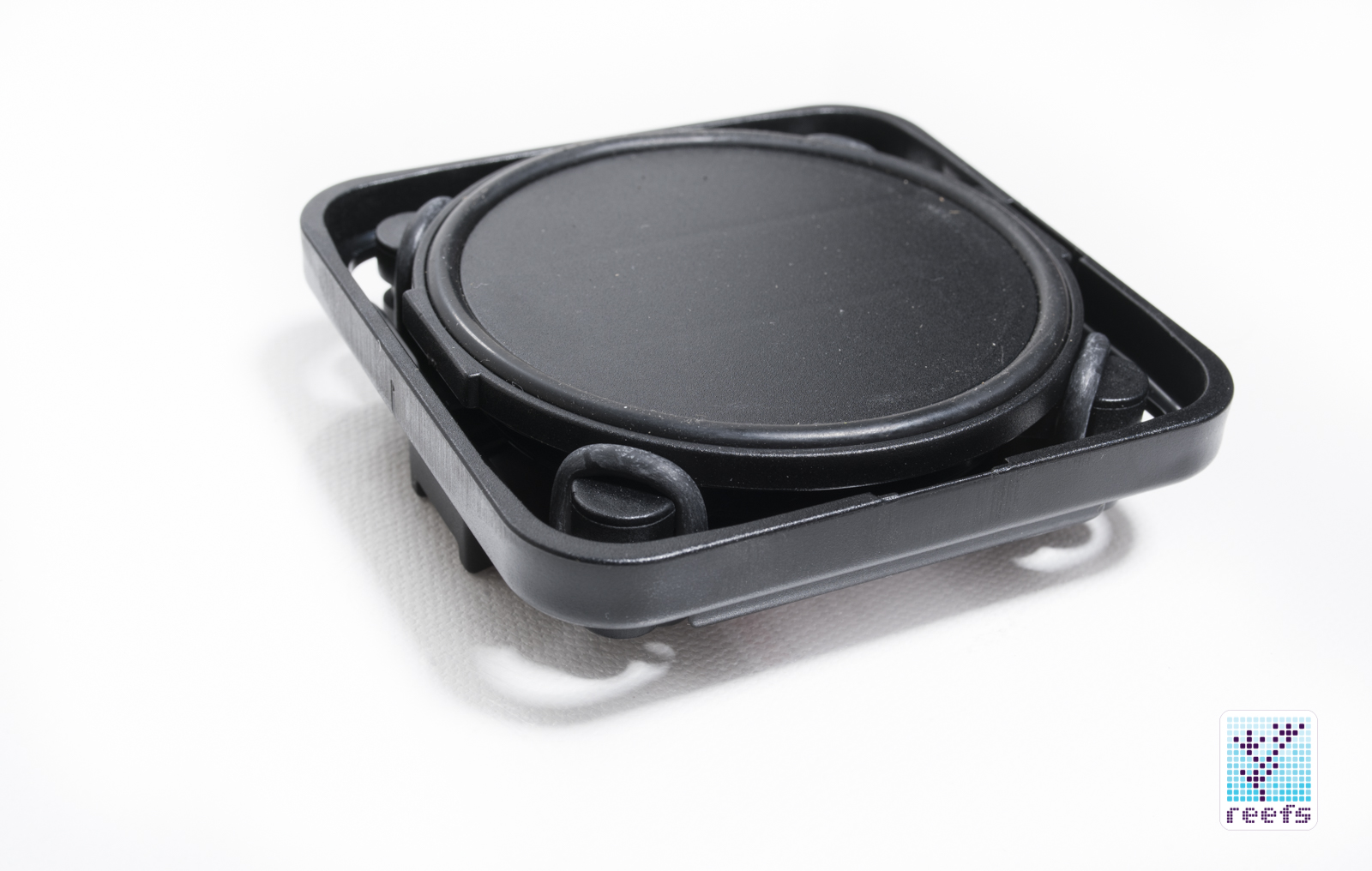
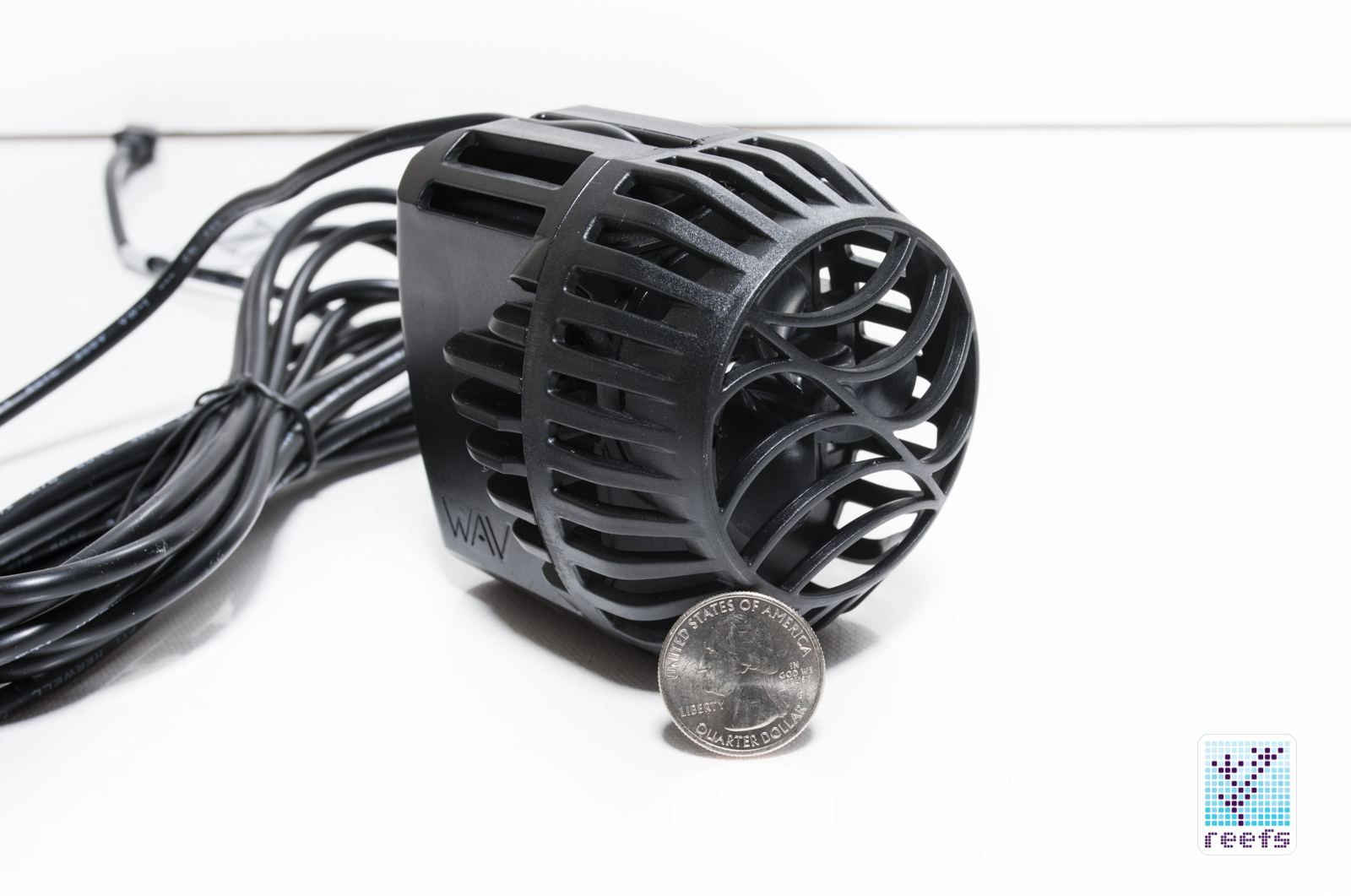
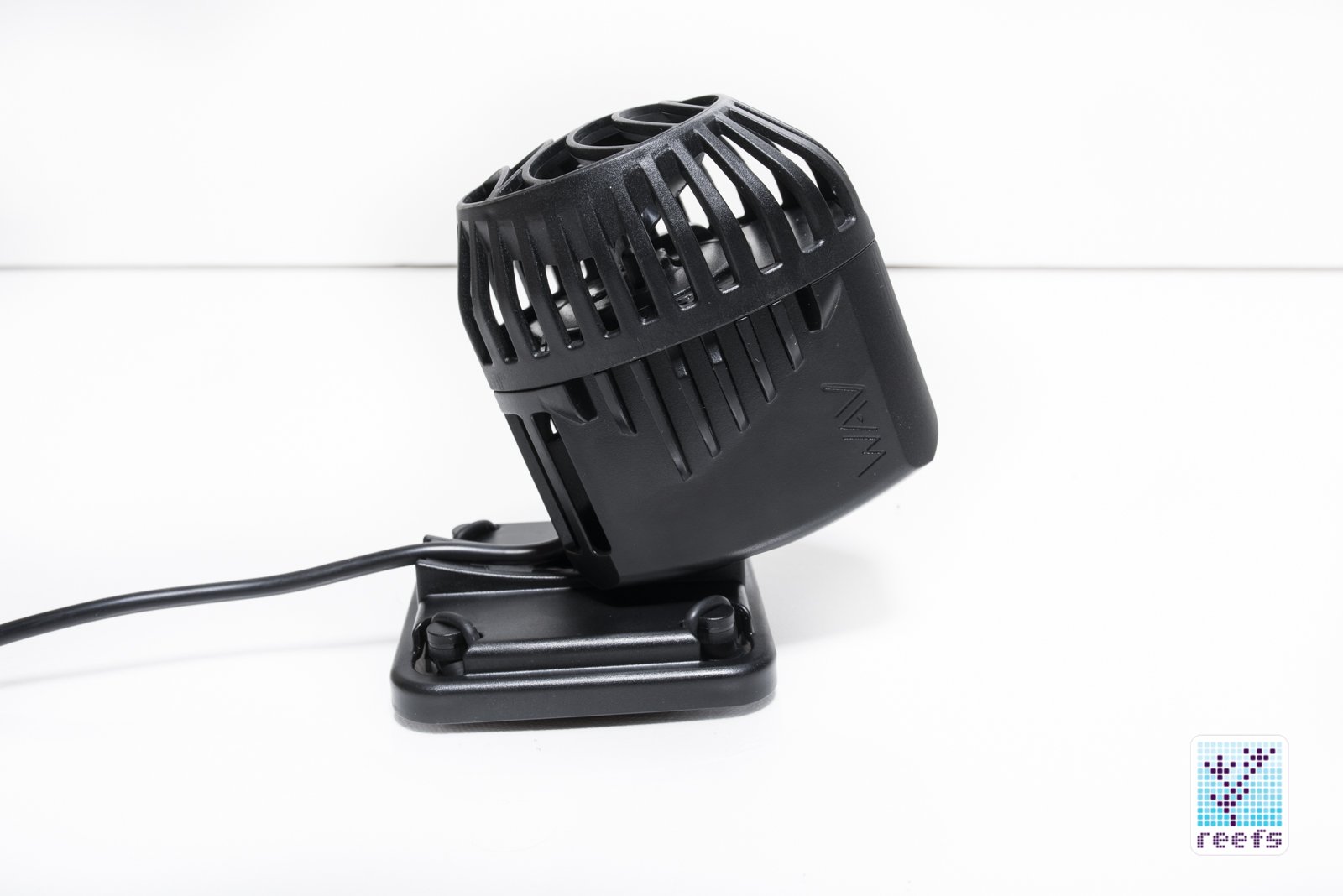
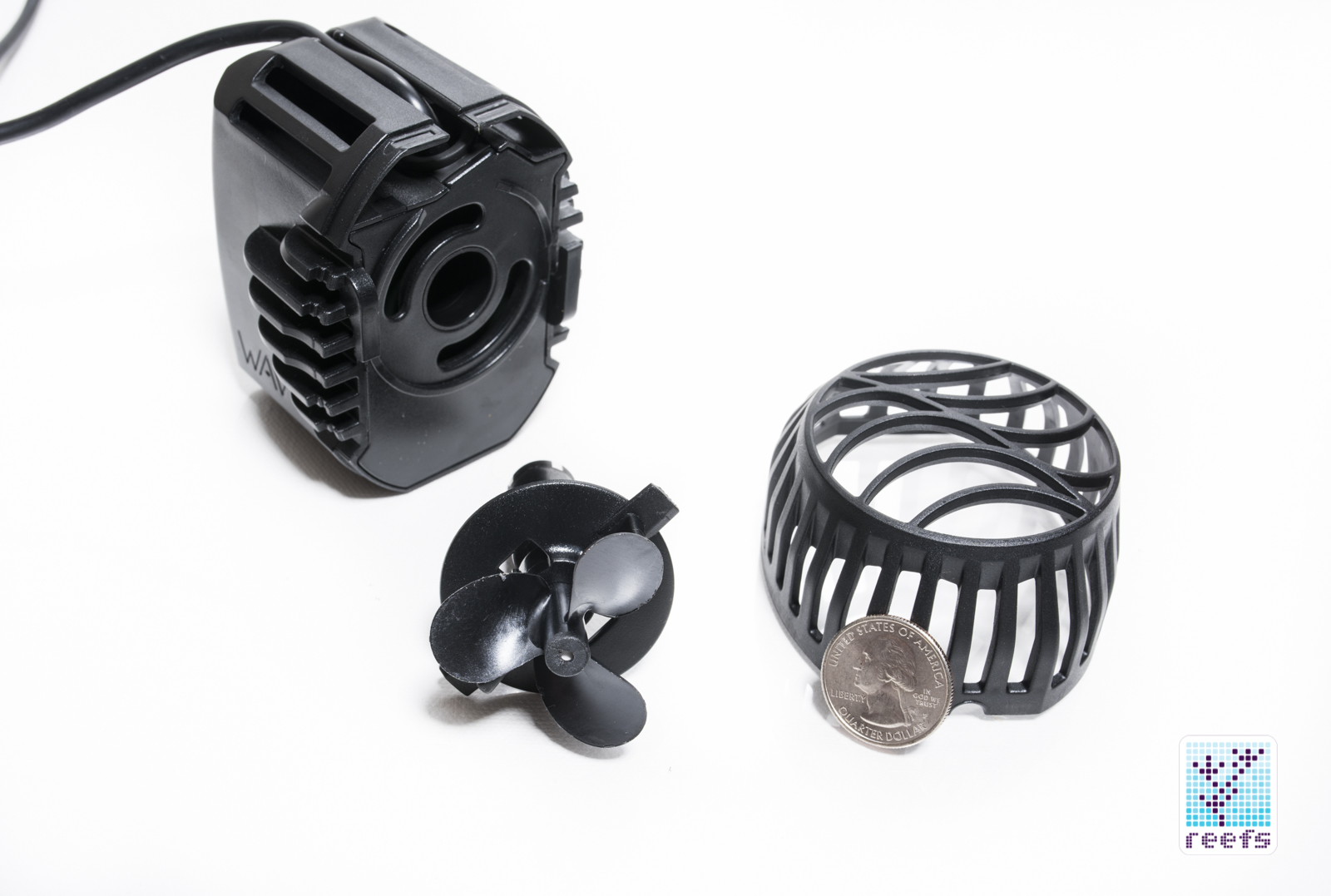
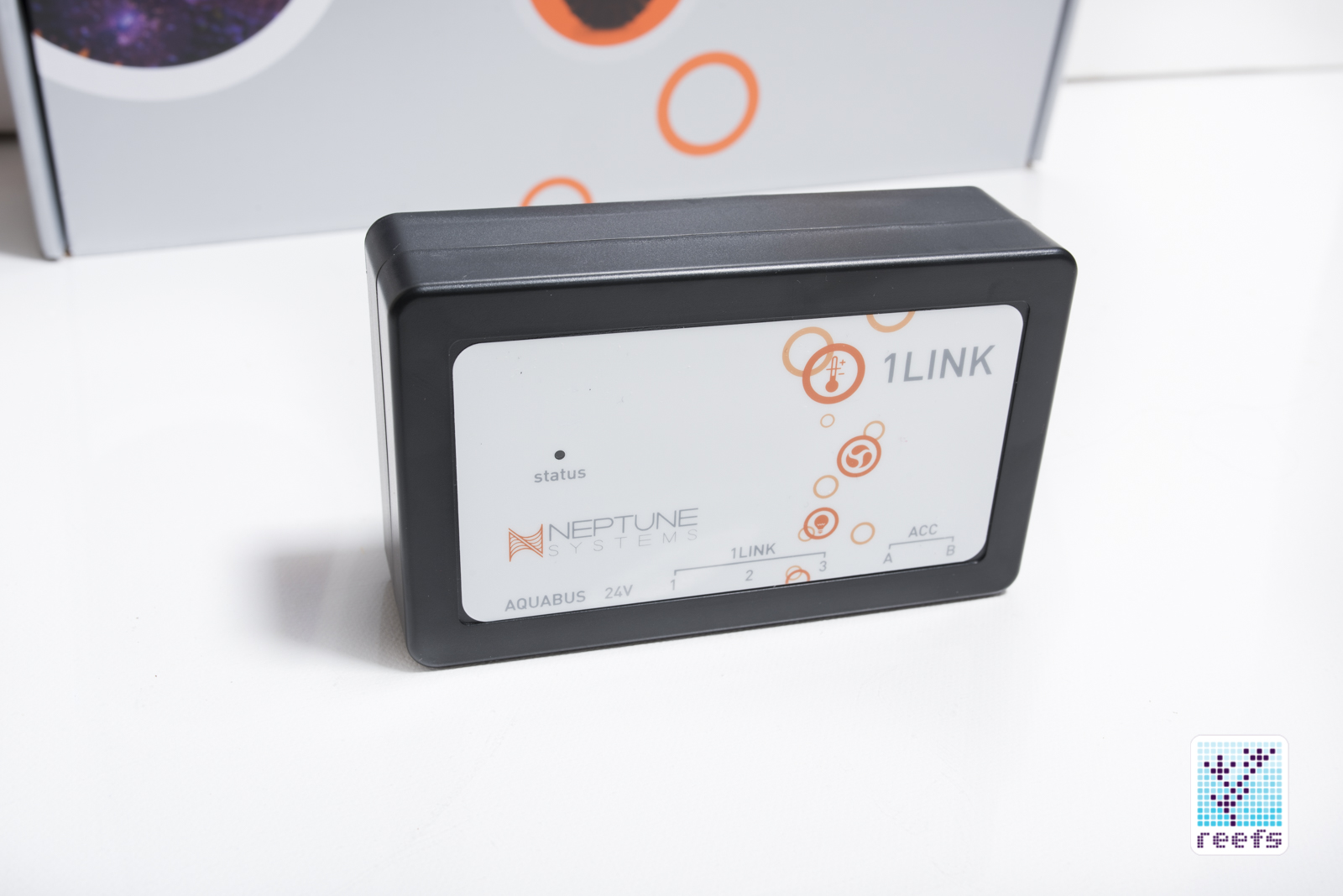
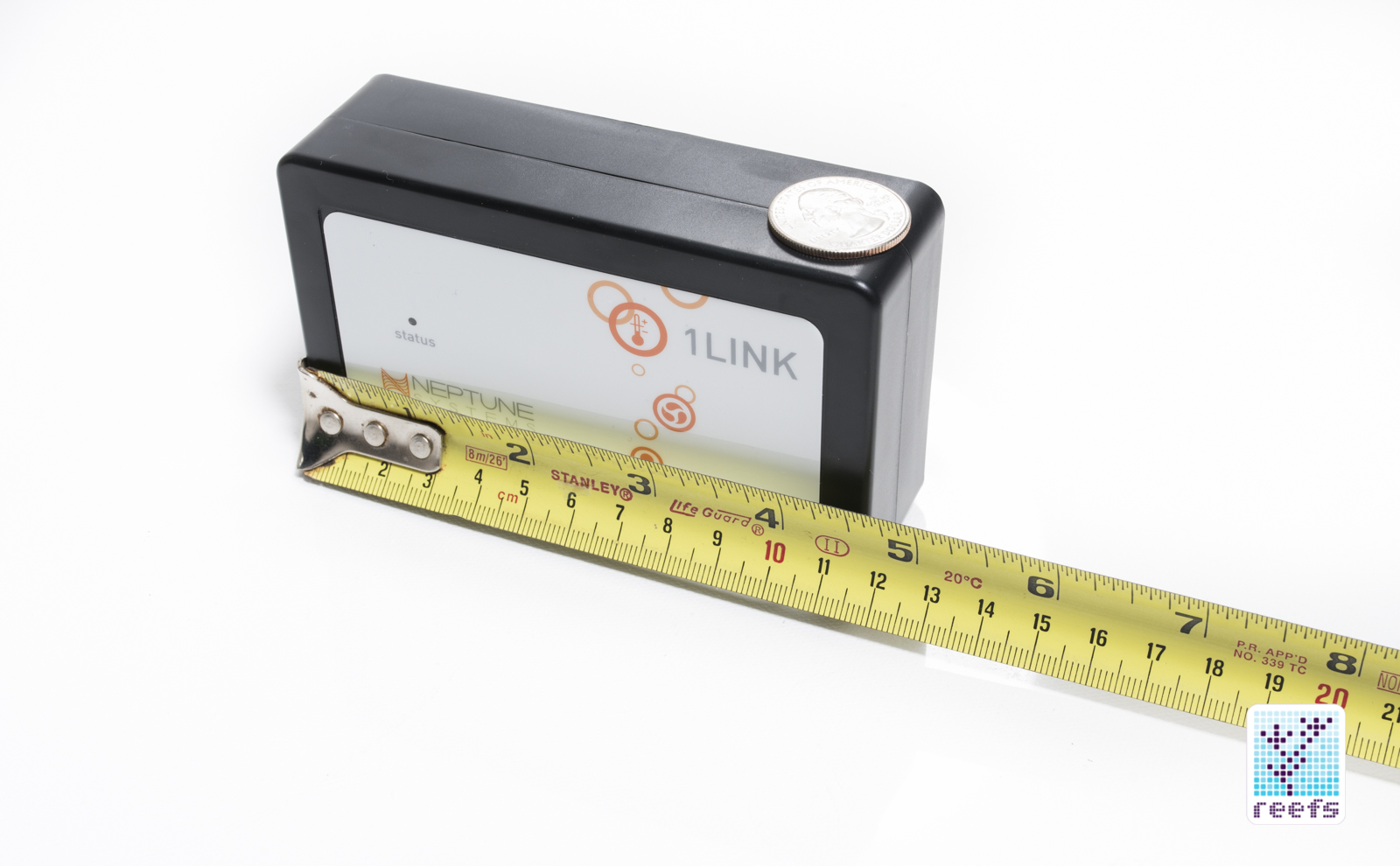
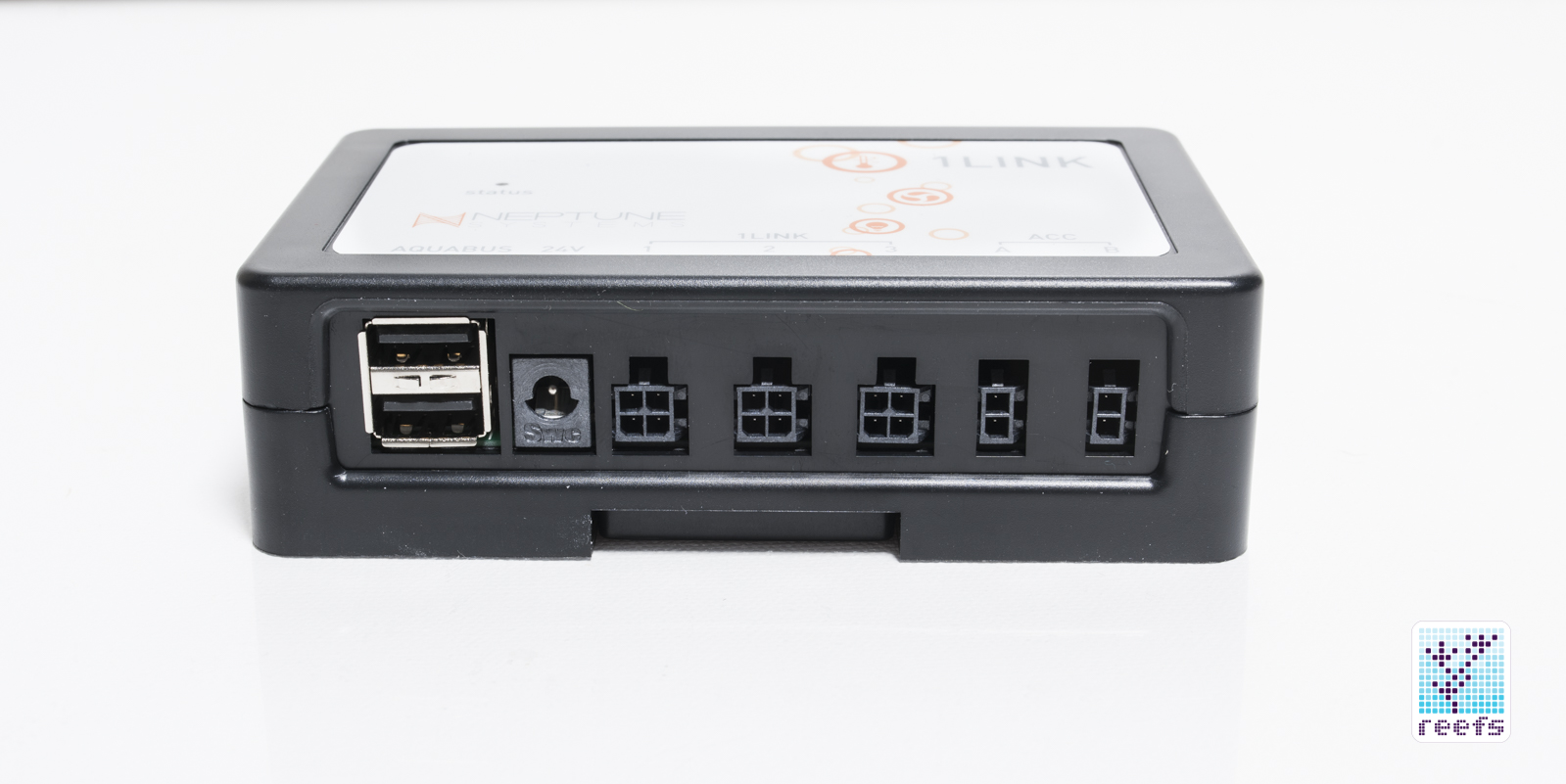
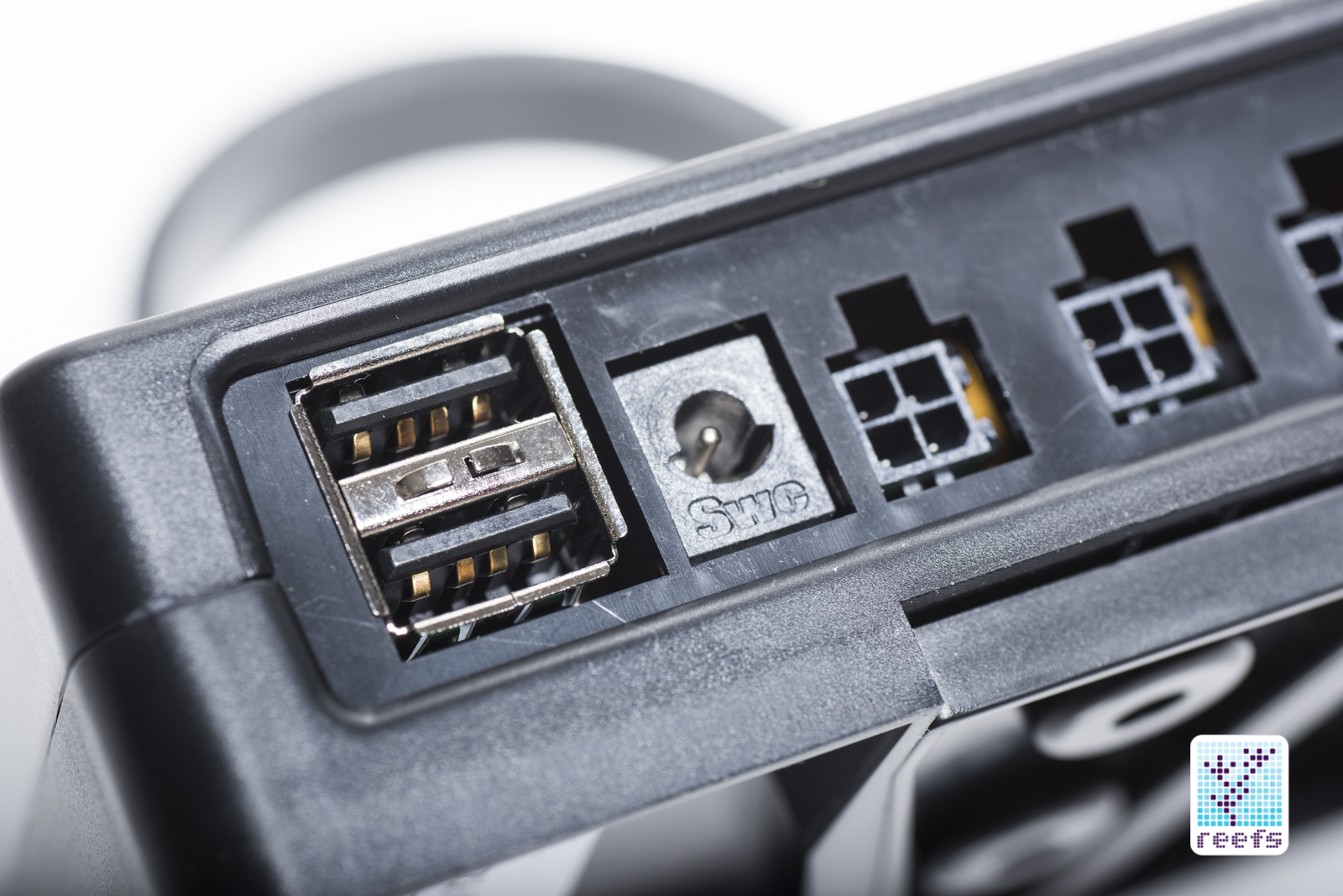
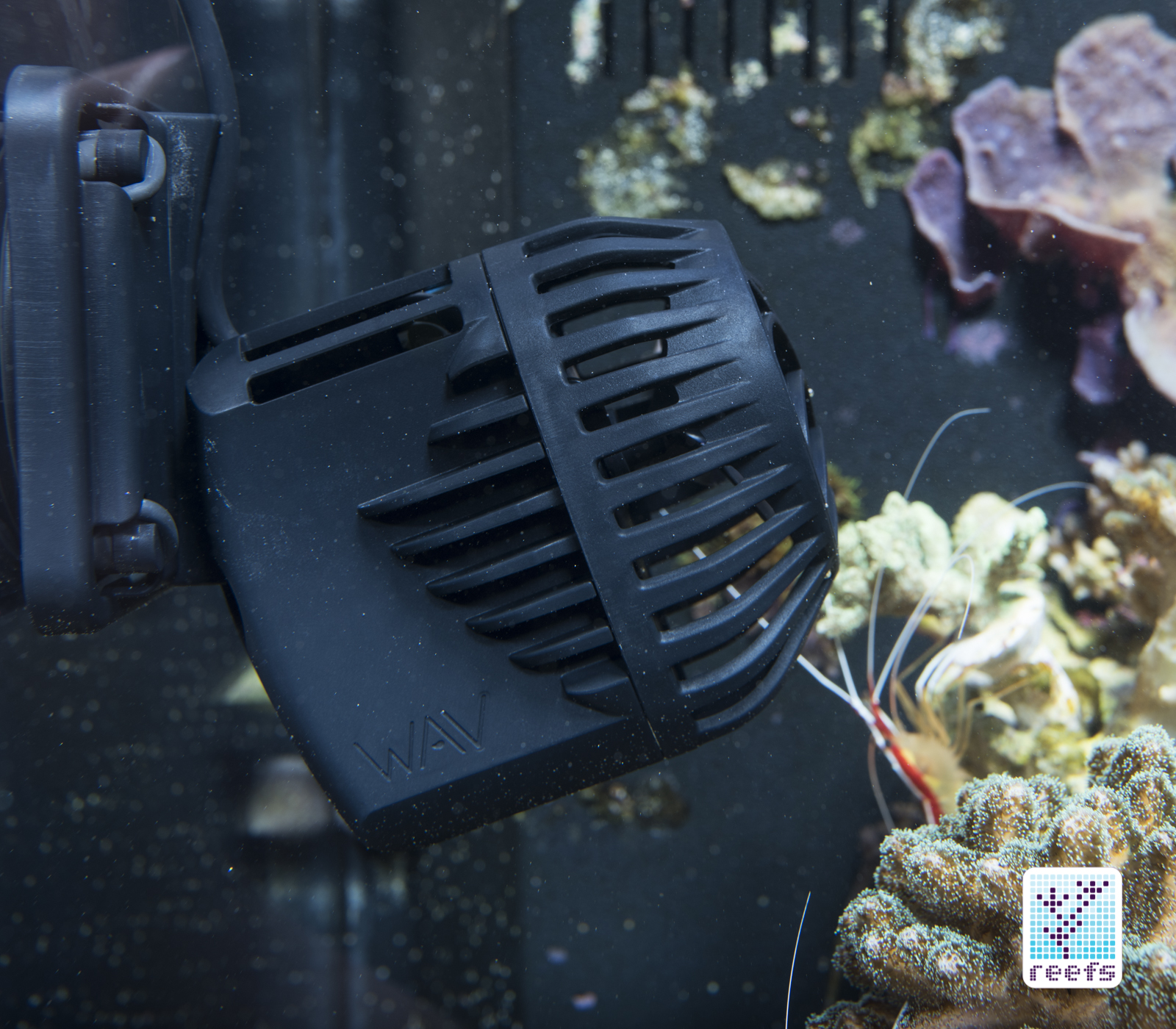
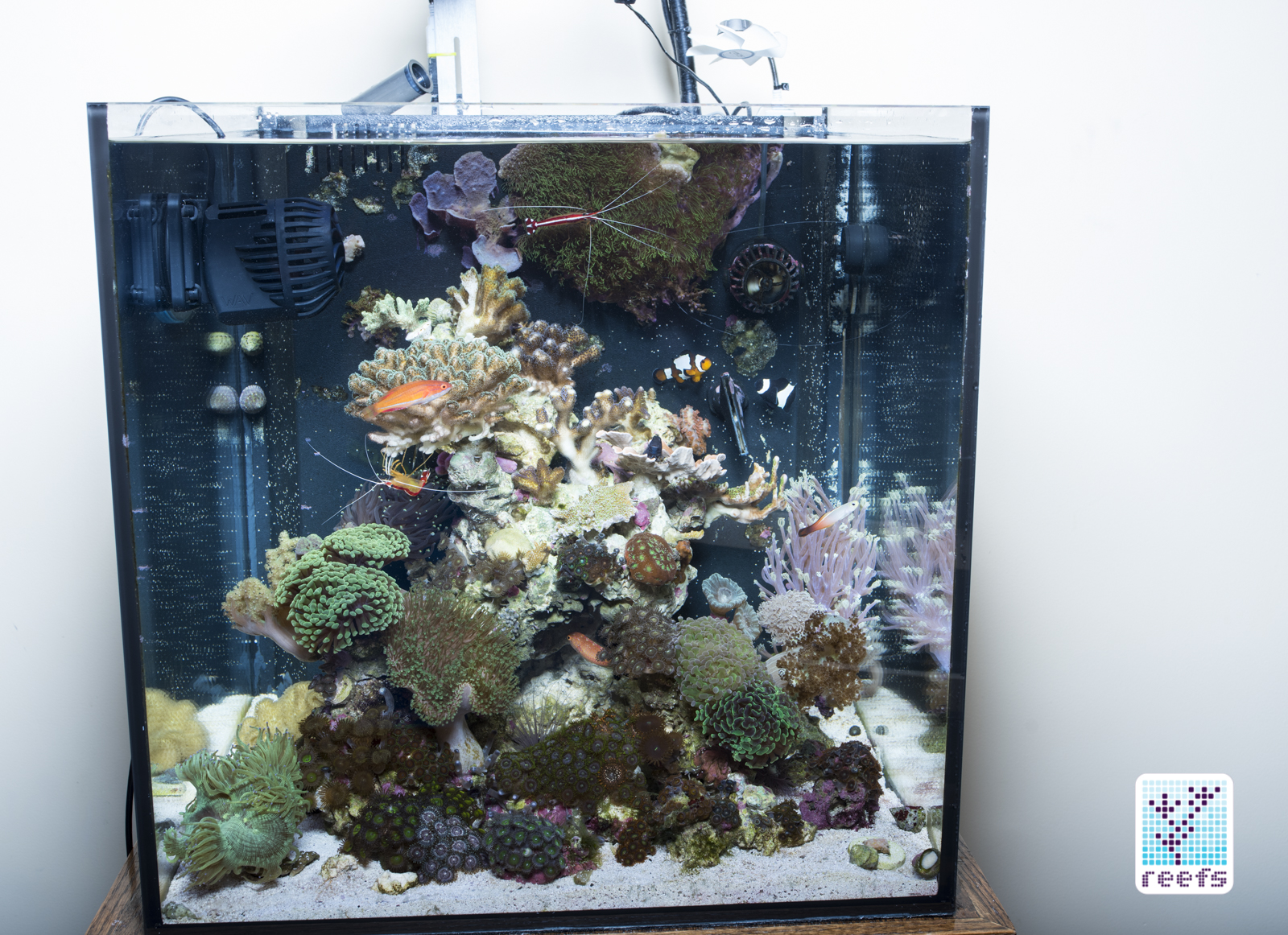


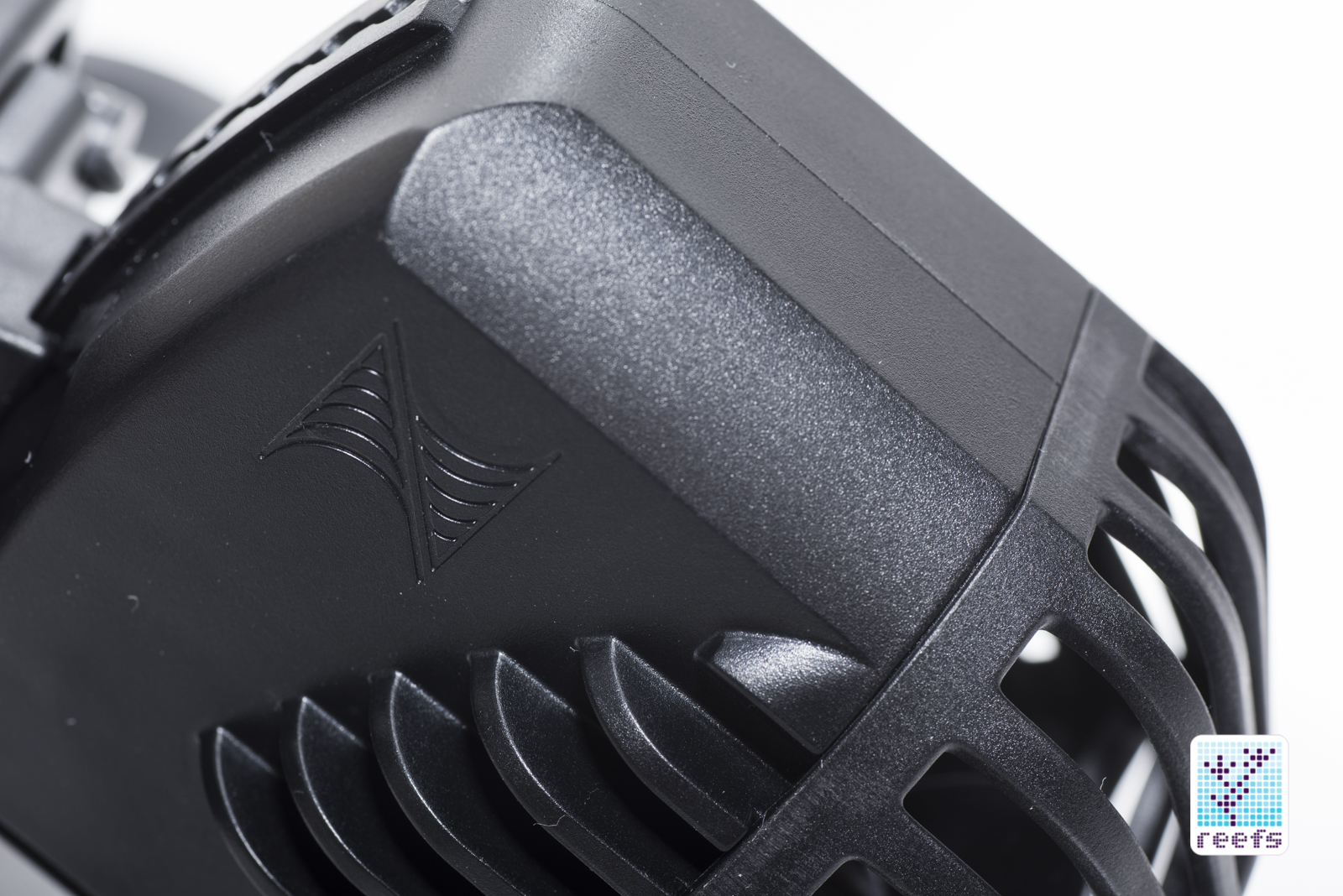
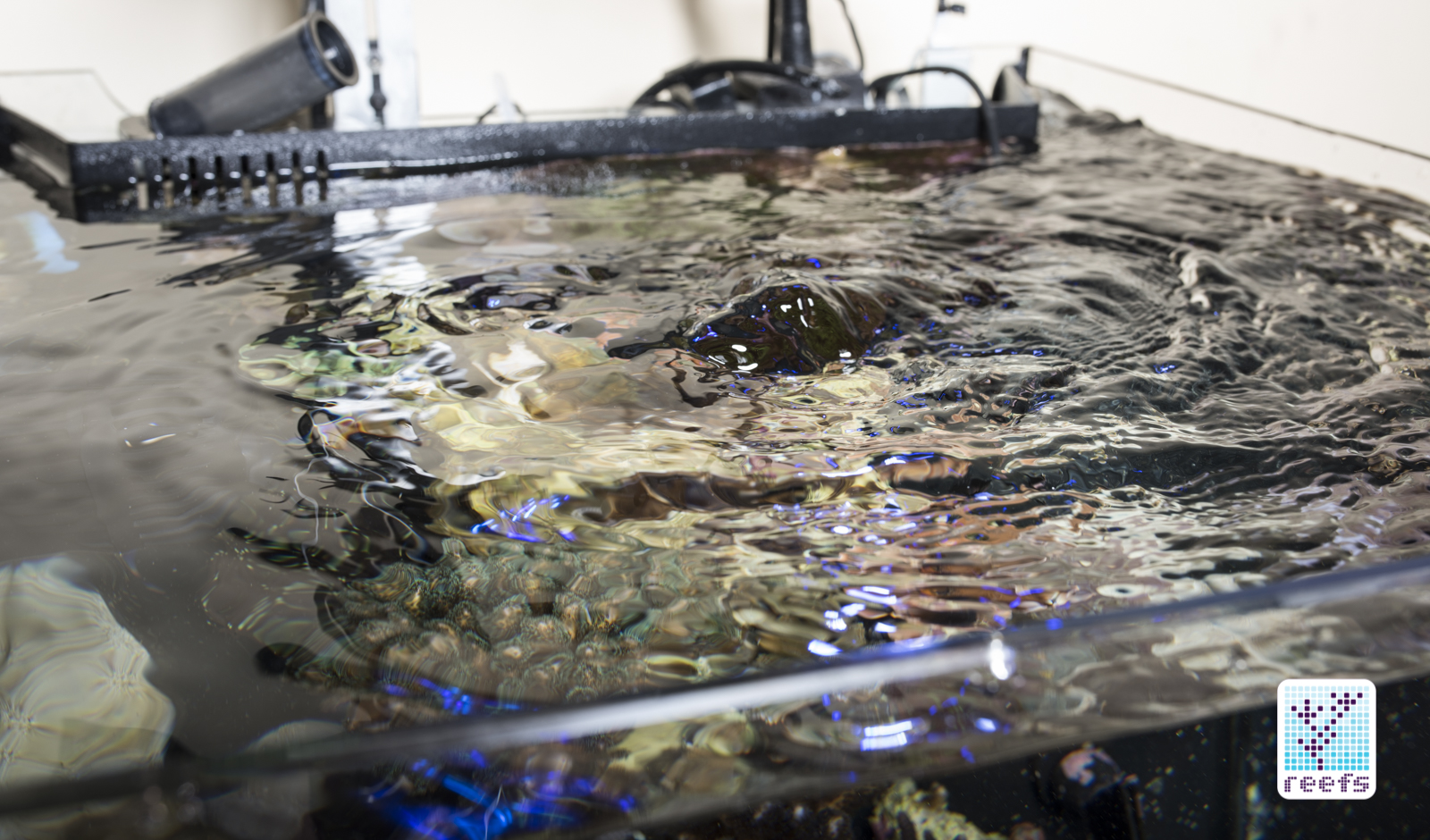
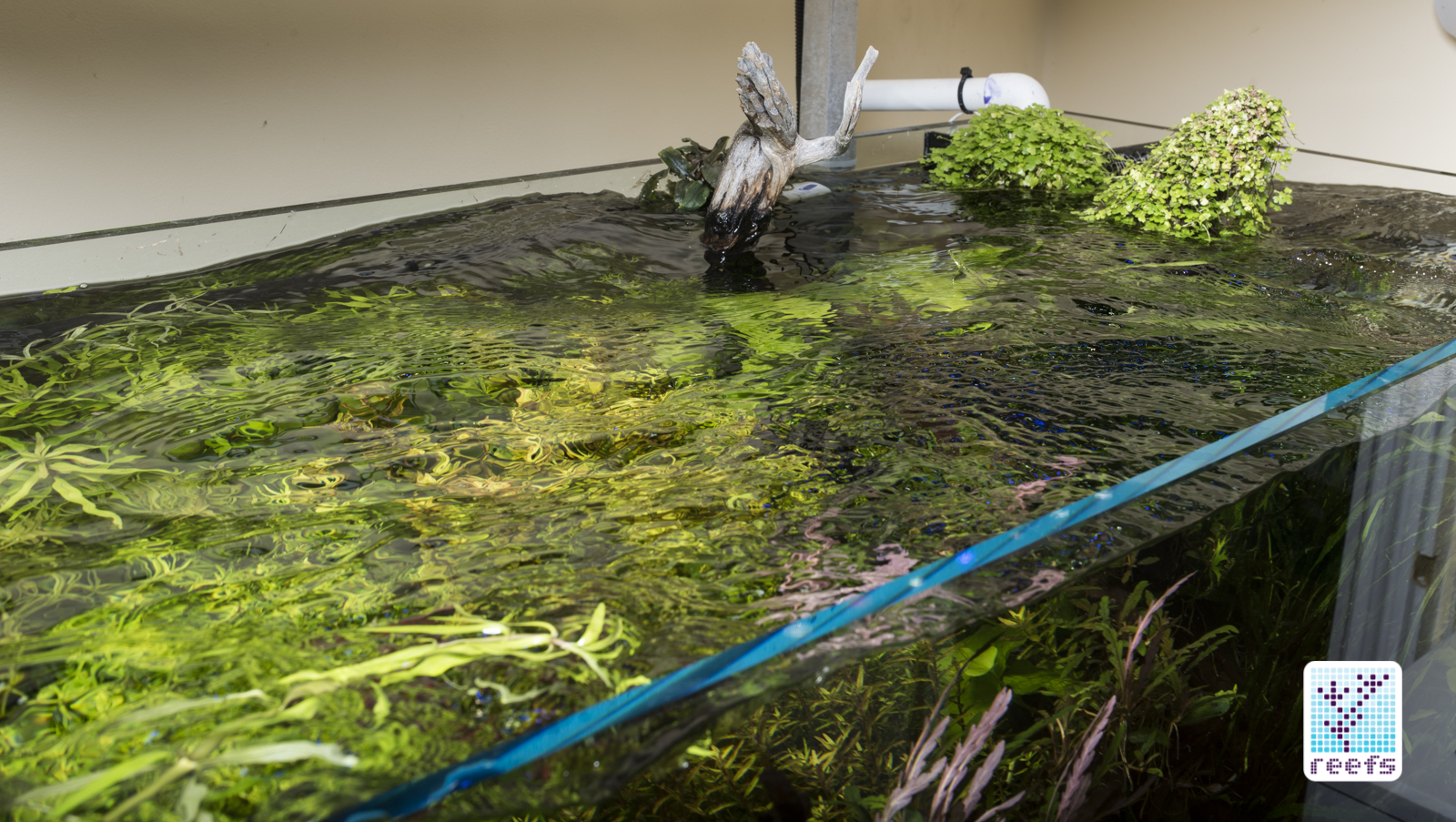
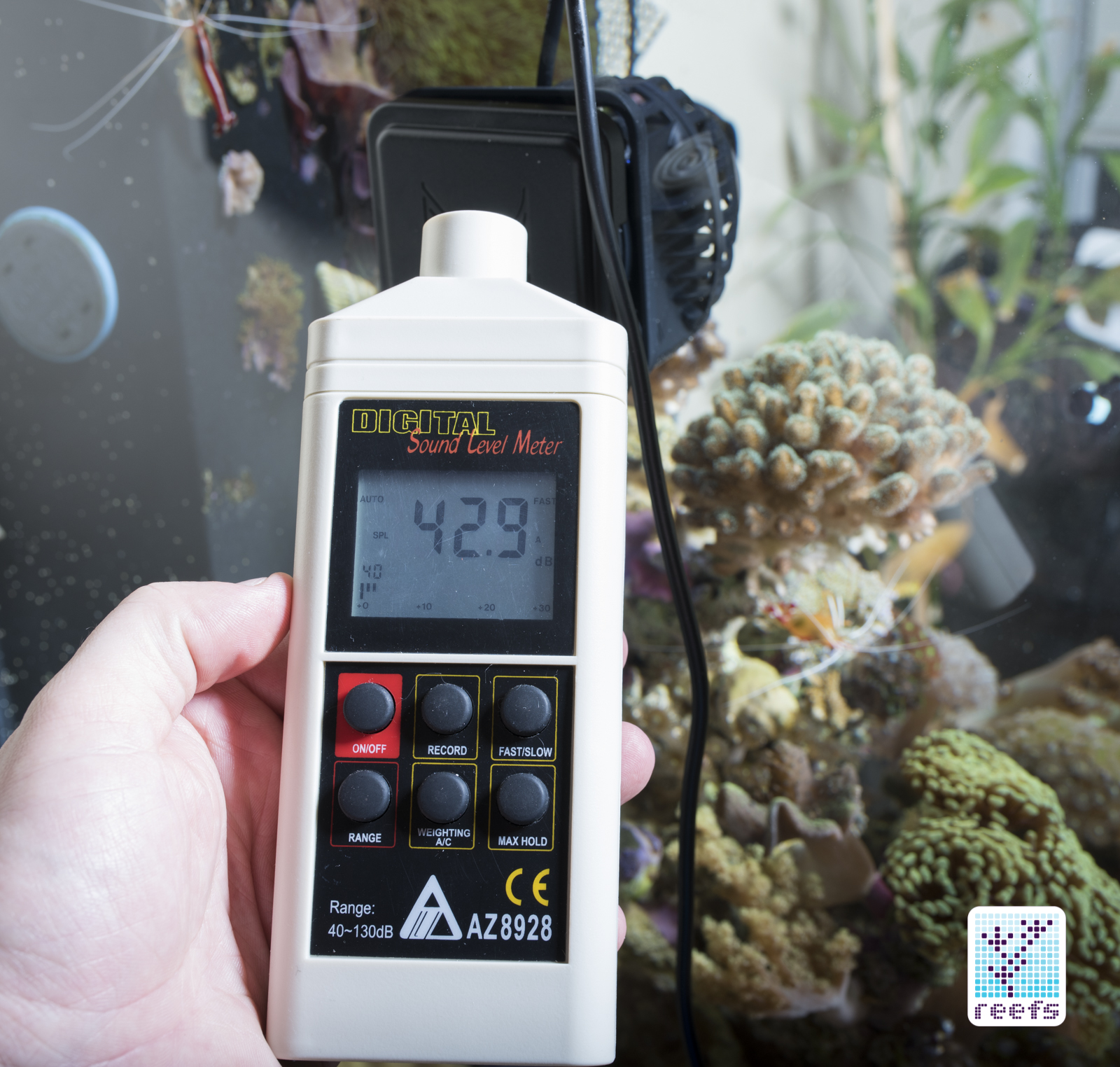
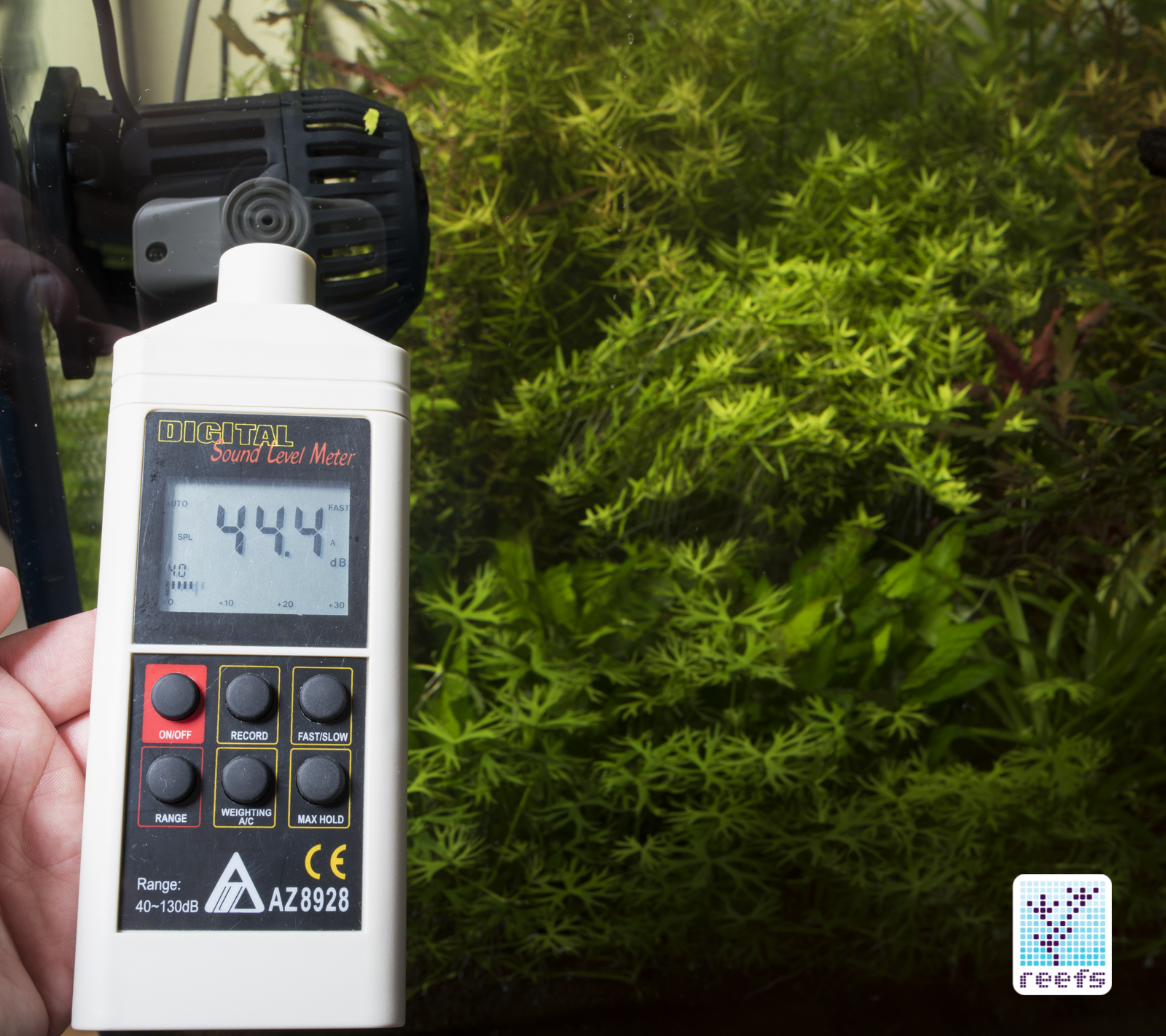
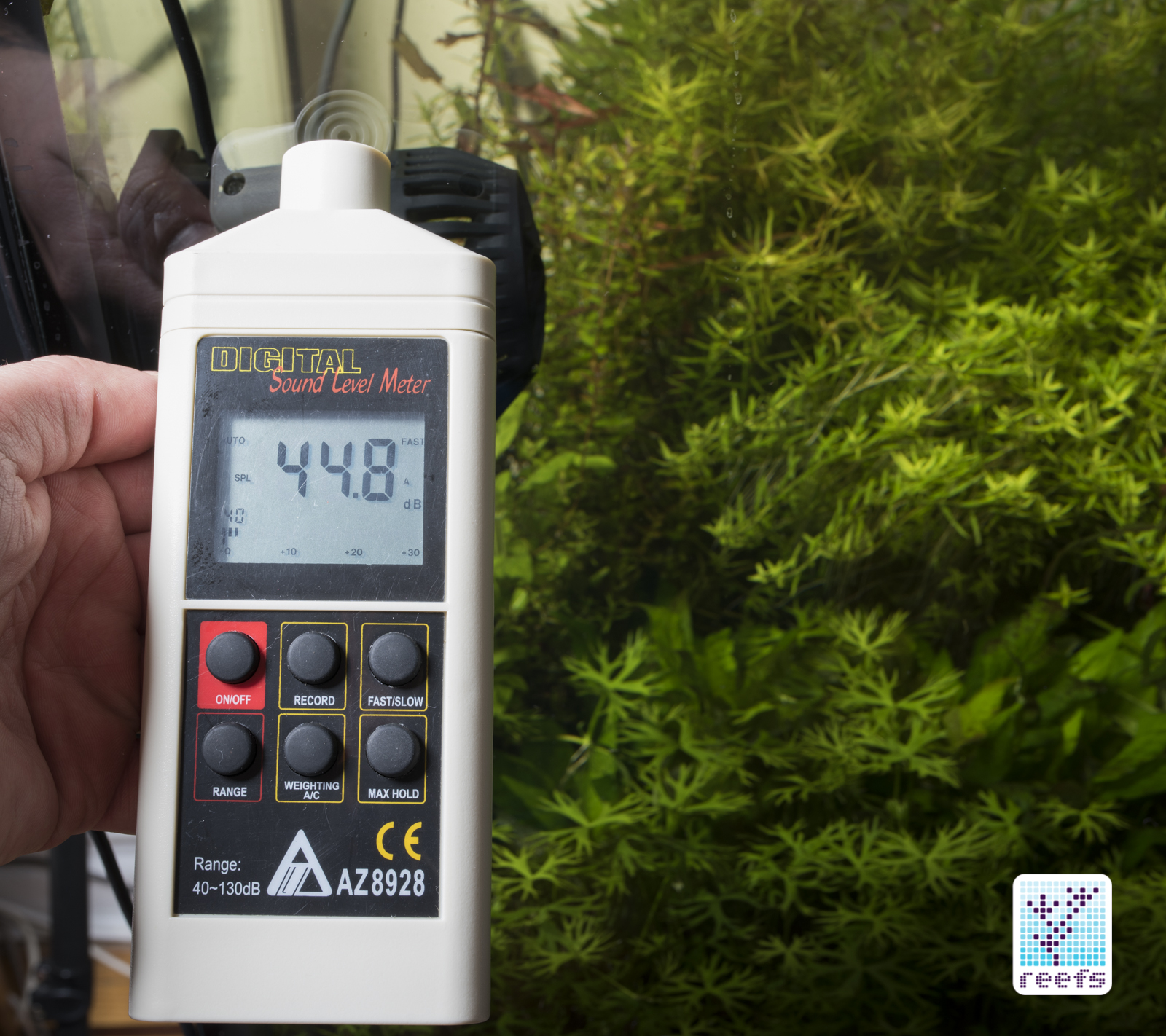
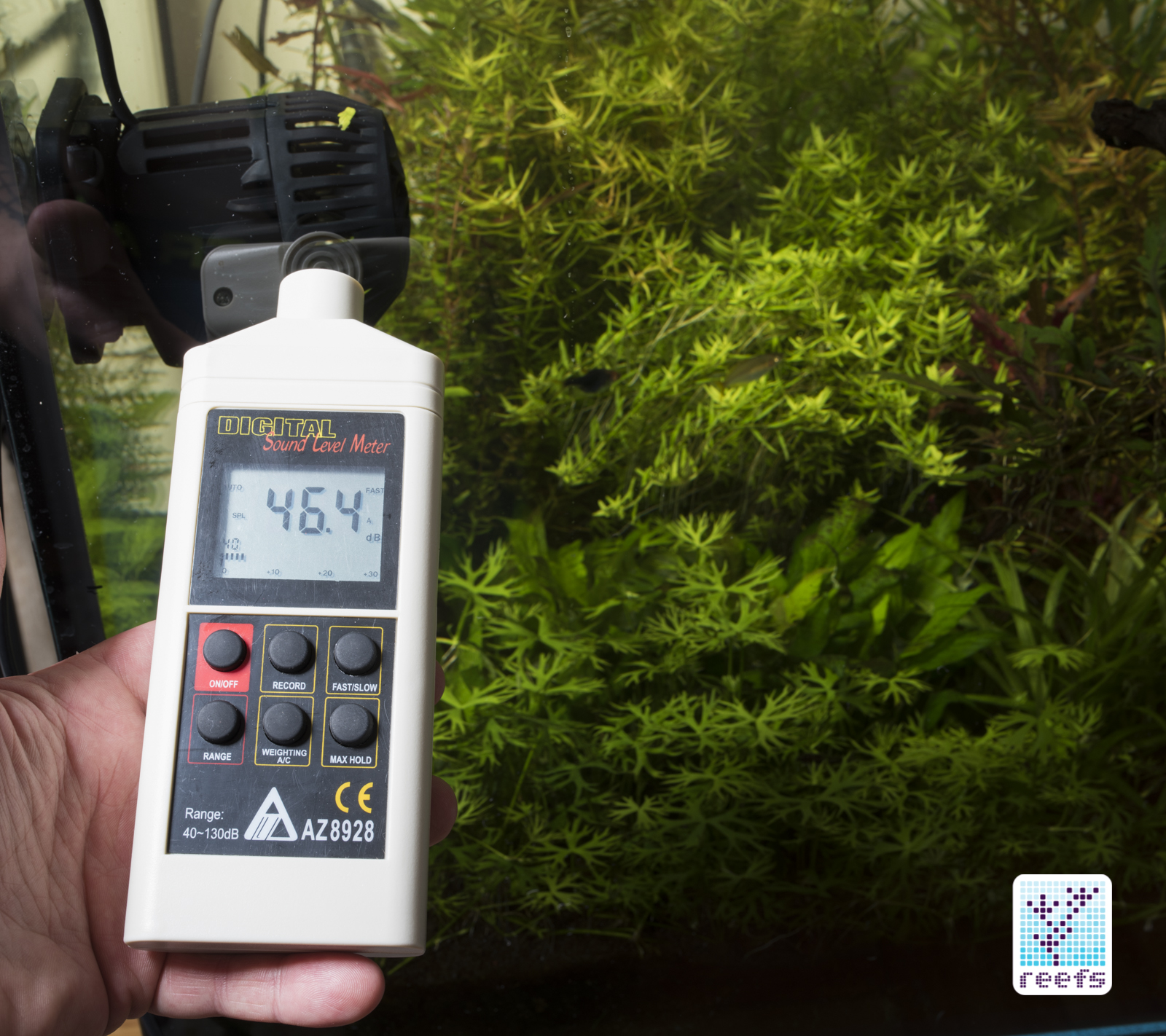
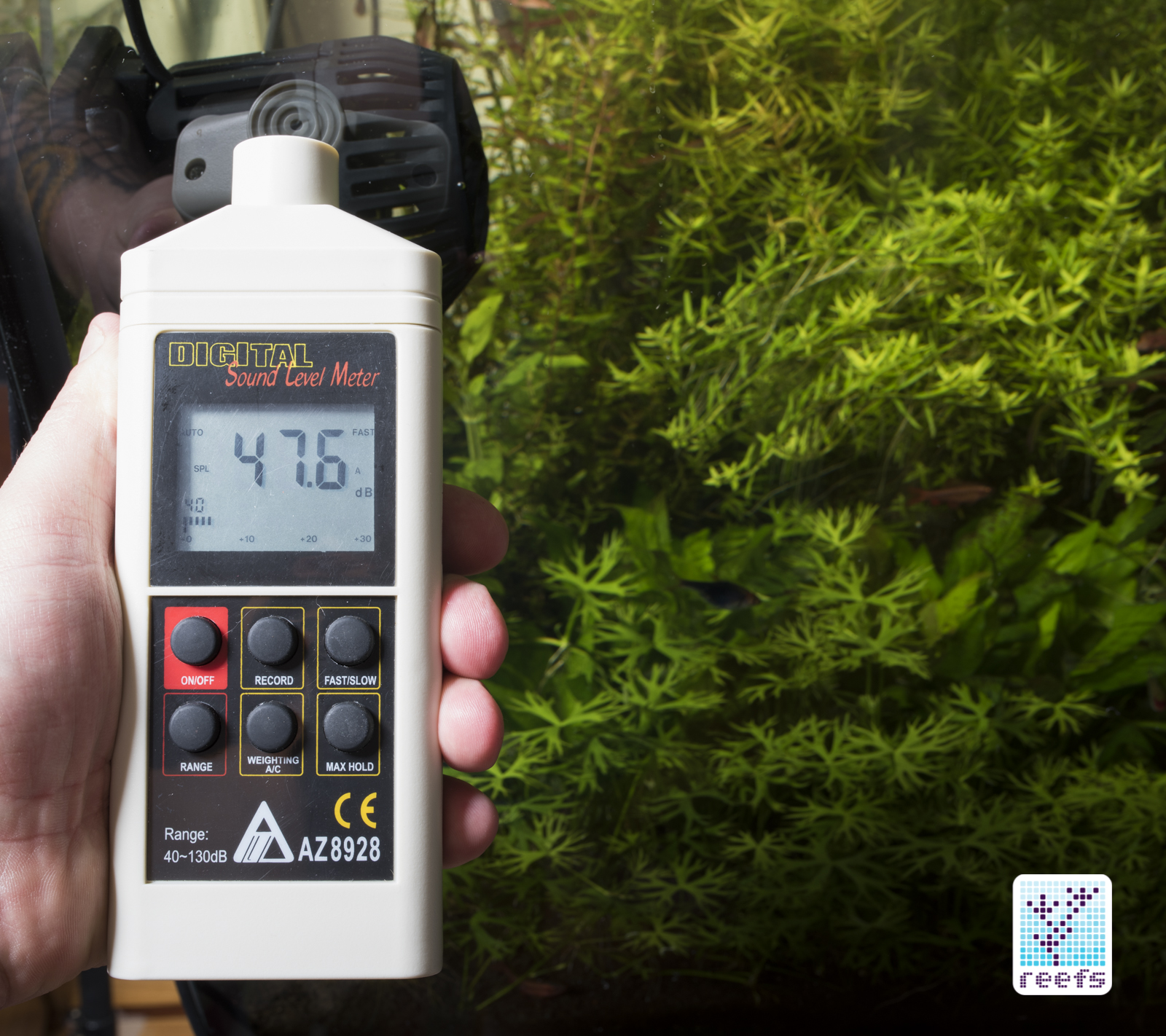
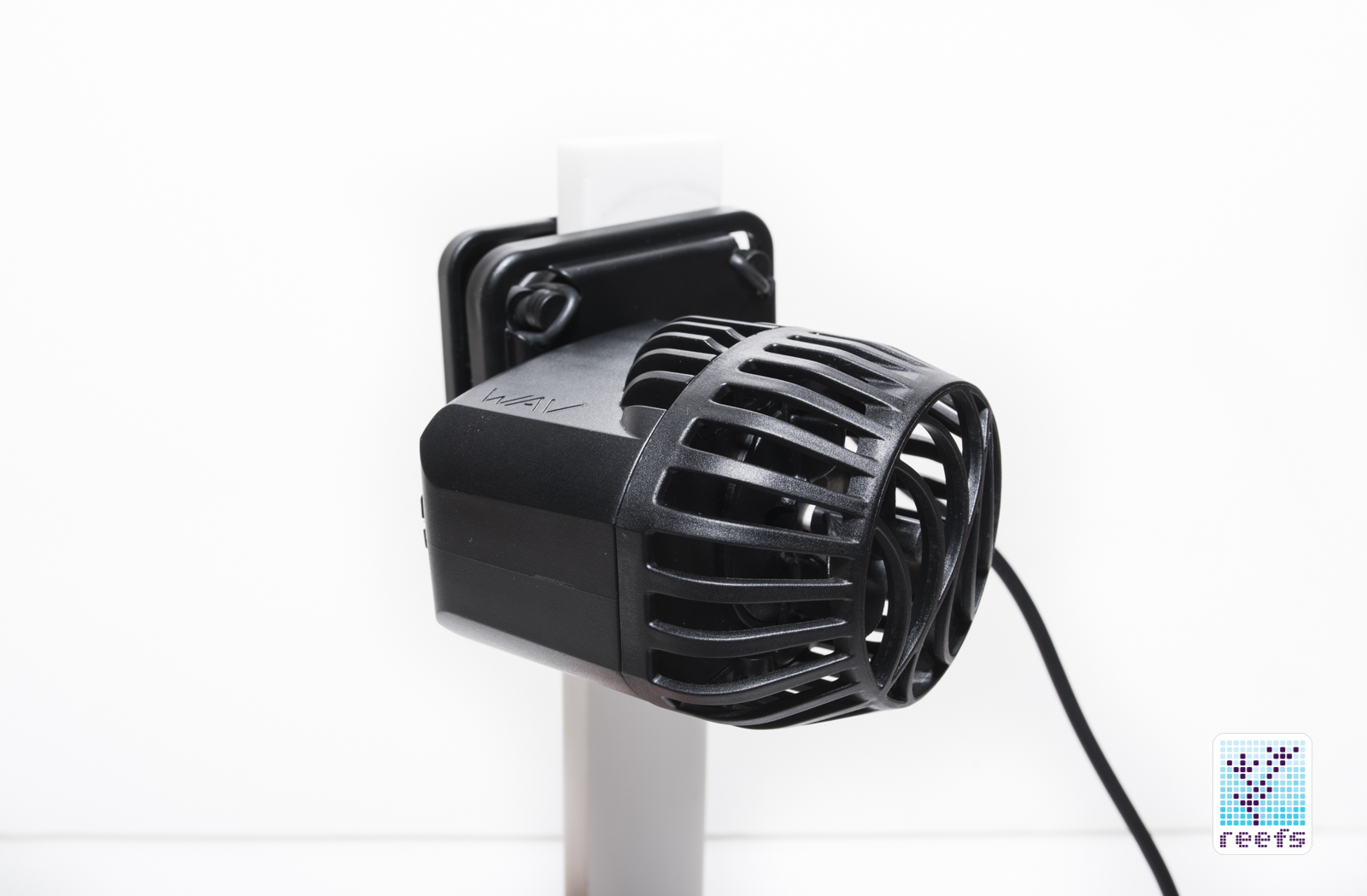
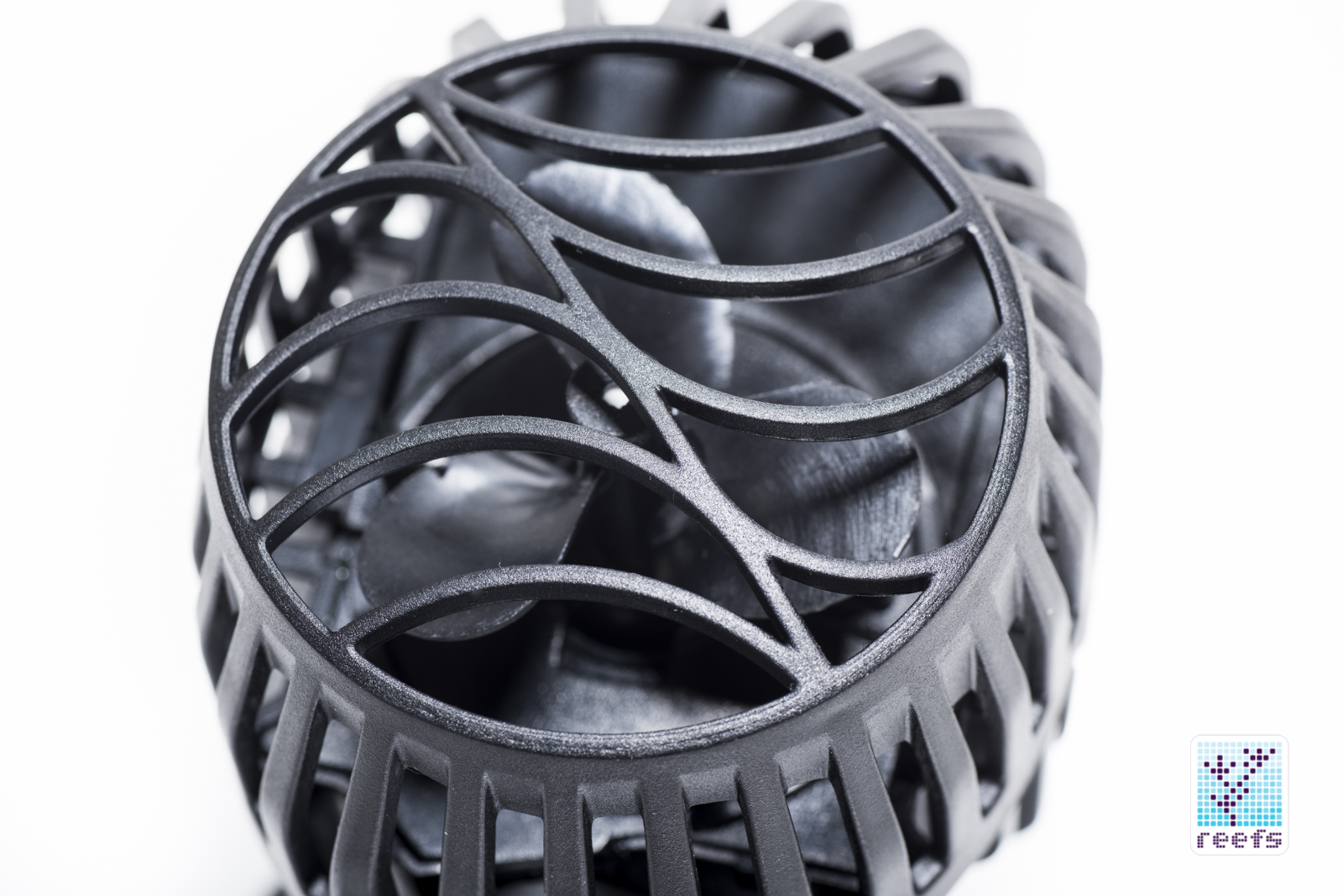
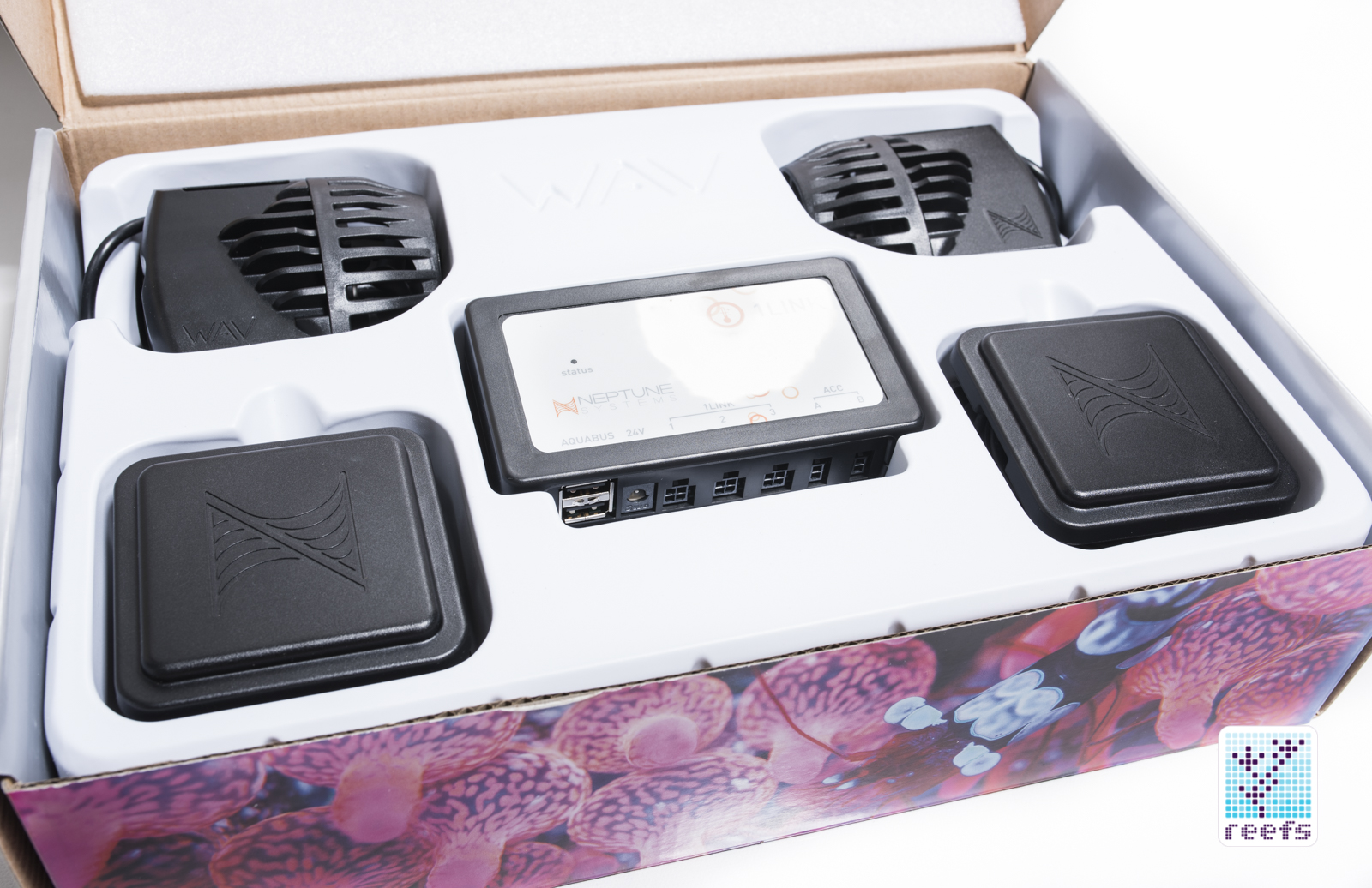
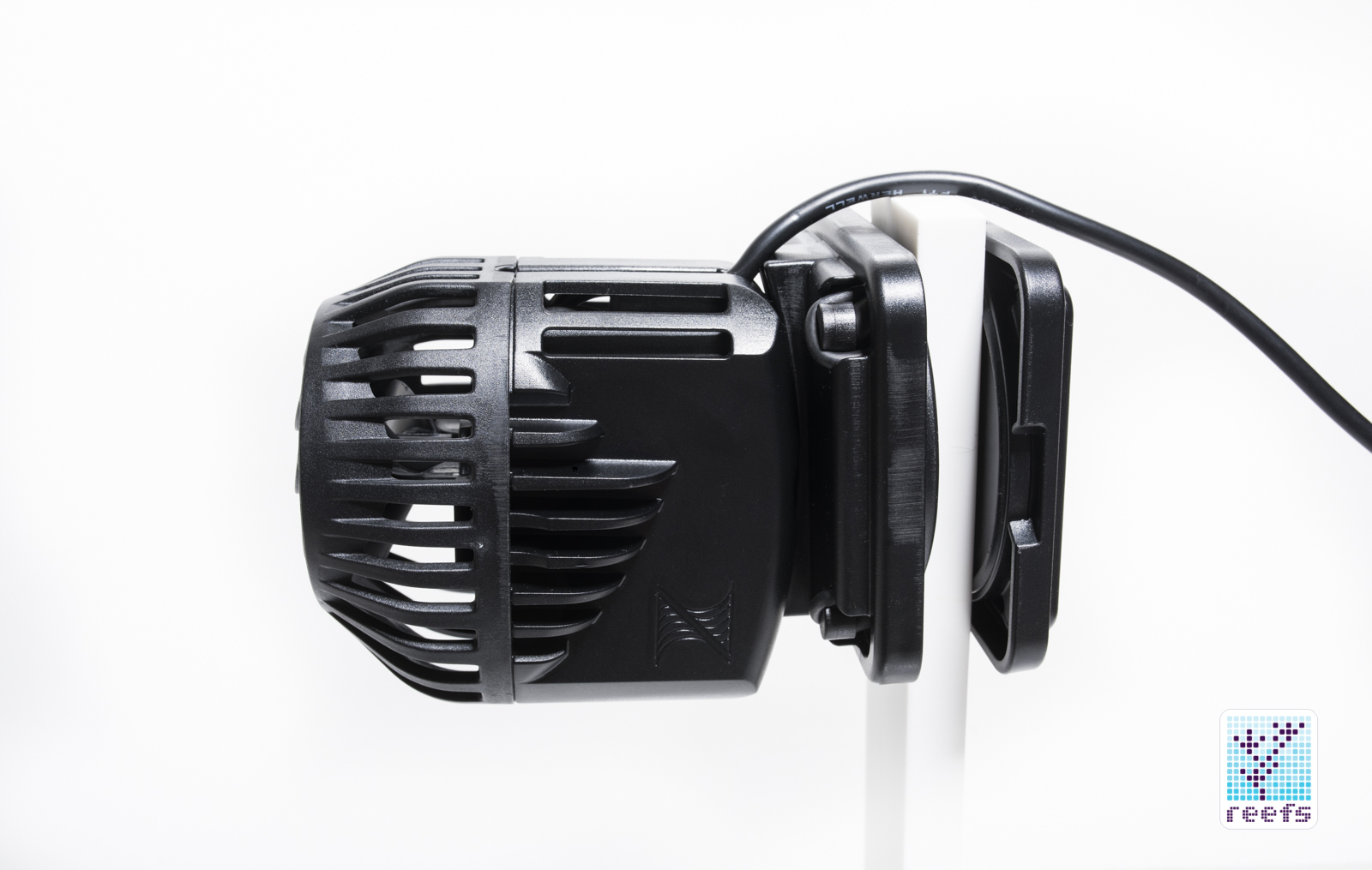






































This couldnt be more true. I had always had freshwater tanks far back as i can remember. Thank my mother for letting me bring home anything with in reason. Trutles, snakes, frogs, you name it and esp. Native to MN fish. But 10 years ago i decided i was board with freshwater and wanted a challenge. I started just like any newbie out there. Learned quickly from my mistakes. Was lucky my mother worked in the used books sales online so i got lots of Birthday books, Including the 3 vol. set of Charles and Juliun Sprungs books. WOW overload. I have to agree that the last 10 years has been an explosion of technology. From leds to plug and play set-ups that are truely amazing right out of the box……